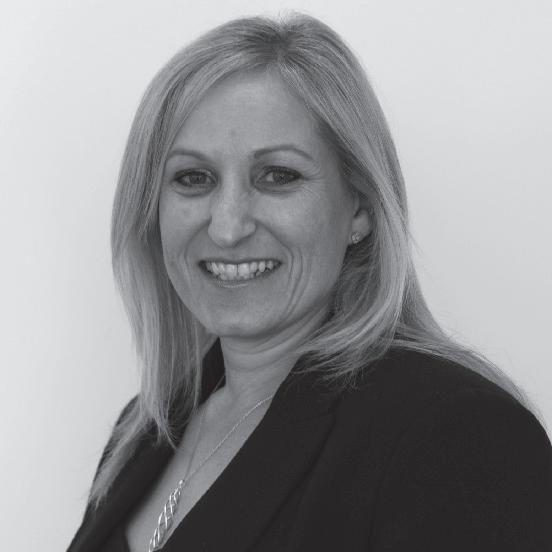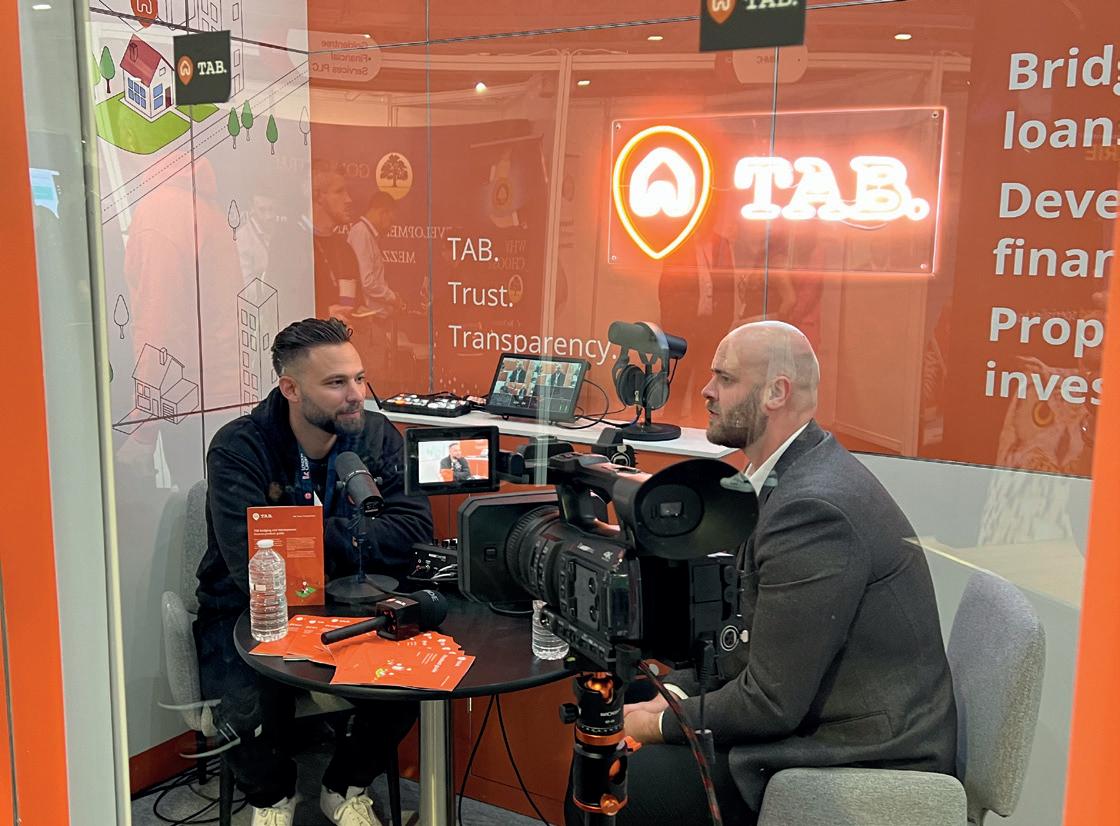ISSUE 24 NOV/DEC 2022 + Blazing a trail for women p22



Up to 75% LTV available Expanded acceptable asset classes No maximum loan size Product and criteria information correct at time of print (01.12.2022)




Partner with a specialist When specialist knowledge, flexible lending and strong broker relationships combine, you get a special effect! Refurbishment lending is one of a number of short-term funding specialisms in which UTB excel. • Conversions and refurbishments • Light (internal) & heavy (structural) works acceptable. • 100% of works costs available • Funding in stages available UTBANK.CO.UK BRIDGING FINANCE PURCHASE | CAPITAL RAISE | CONVERSION & REFURBISHMENT | DEVELOPER EXIT THE SPECIALIST EFFECT
CBP008214 To read about our commitment to the environment and sustainable print publishing, please visit https://bridgingandcommercial.co.uk/page_magazine. Acknowledgments Editor-in-chief Beth Fisher Creative direction Beth Fisher Sub editor Christy Lawrance Senior reporter Andreea Dulgheru Reporter Kit Million Ross Contributors Stephanie Baxter Christopher Marchant Photography Alexander Chai Sales and marketing Beth Fisher beth@medianett.co.uk Special thanks Scott Angus, HTB Andy Reid, Pivot Amanda Overland, Sancus Extra special thanks Caron Schreuder Printing The Magazine Printing Company Design and image editing Russ Thirkettle, Carbide Finger Ltd Bridging & Commercial Magazine is published by Medianett Publishing Ltd Publishing director Beth Fisher beth@medianett.co.uk 0203 818 0160 Follow us: Twitter @BandCNews | Instagram @BridgingCommercialMagazine
Relationships and trust are often described as the foundation blocks of the specialist lending industry—and for good reason. With the economic environment uncertain amid rising rates and costs, brokers are needed more than ever to solidify the best and most reliable finance partnerships for their clients. This is why we’re ending the year by celebrating a variety of unique personalities within the market.
The People Issue provides interviews with key professionals about their journey in the sector and who inspired them along the way [p10], why specialist advice will become increasingly important in 2023 [p46], and why having a background in both lending and broking offers an advantage [p80].
We look at how female leaders can help encourage and inspire more women into the financial services industry [p22], why neurodiversity should be embraced [p88] and the topic on everyone’s minds right now—should clients be fixing their bridging loans? [p30]
We also interview those who have recently taken new leadership roles, including UTB’s new director of bridging Sundeep Patel [p38], Sancus’ UK managing director Richard Whitehouse [p74], and Spring Finance’s CEO Gavin Diamond [p66].
As discussed in this issue’s In Conversation roundtable [p52], borrowers will need to invest in quality and reliable advice, backed by solid industry experience, to ensure their projects are fully funded and successful in a volatile market. One expert summed this up perfectly: “The brokers who’ve been around for a while—specialist advisers and consultants who’ve come back into the market from the banking world—are going to be sought after because their knowledge is based on reality.”
Beth Fisher Editor-in-chief
Nov/Dec 2022 3
The Sun and Moon
Two things you can always depend on being there.
Well now there’s a third.
West One’s fast, flexible and reliable service, gets the funding your clients need, when they need it.
Even in an uncertain market, we provide multi-product financing packages that can overcome the challenges in the most complex of cases for residential-led, semi-commercial and commercial projects.
You can always rely on West One.
So, give us a call today on 0333 1234556 to discuss your case, regardless of its complexity or your client’s level of experience.
to see
guide
Bridging Loans Buy-to-Let Mortgages Development Finance Second Charge Mortgages
is 09425230.

Scan
our product
West One is a trading name of the underlying firms, who are registered in England and Wales and have their registered office address at The Edward Hyde Building, 38 Clarendon Road, Watford, WD17 1J. West One Loan Ltd is authorised and regulated by the Financial Conduct Authority (firm reference number 510024), their company registration number is 05385677. West One Secured Loans Ltd is authorised and regulated by the Financial Conduct Authority (firm reference number 776026), their company registration number
West One Development Finance Ltd is not authorised by the Financial Conduct Authority, their company registration number is 11242570 Aura Finance Ltd is authorised and regulated by the Financial Conduct Authority (firm reference number 709675), their company registration number is 08326315. Certain types of loans are not regulated, for example loans for business purposes or certain buy-to-lets.

10 16 22 30 38 52 66 80 90 96
Bridging & Commercial 6
A lot of women want to see role models and that the path has been trodden, and how it can be done”
p22
The Cut Who inspired who? News Happy birthday, Redi Finance! Exclusive The key to welcoming more women in development finance Zeitgeist Riding the curve on a variable rate Feature United Trust Bank / Arc & Co In Conversation It’s all about the maths Interview Gavin Diamond / Richard Whitehouse View Changing perspectives/ Embracing neurodiversity Limelight 1,400 professionals gather in London Backstory Tom Cantor


Blackfinch Investments Limited is authorised and regulated by the Financial Conduct Authority. Registered address: 1350-1360 Montpellier Court, Gloucester Business Park, Gloucester, GL3 4AH. Registered in England and Wales Company Number 02705948. • Lending against both residential and commercial property • Loan term typically from 6 to 24 months • Loan amounts typically £1m to £25m • Loan to value (LTV) up to 75% • Loan to cost up to 90% • Geographical coverage across the UK Get in touch today on propertyenquiries@blackfinch.com and see how we can help you Fully-Funded Lender Fast and Flexible Approach ESG-Aligned Principles In-House Legal Team Looking for a Bridging & Development Finance partner? At Blackfinch Property, we’re dedicated to helping rejuvanate local areas and economies
Bridging & Commercial 10
Who is your role model?
Everyone has somebody who inspires them—their own real-life superhero. Some of the industry’s notable figures, each with over 15 years of experience, name those who helped them reach where they are today
The Cut
Nov/Dec 2022 11
One of the first role models who comes to mind is David Anderson, former chief executive at Yorkshire Building Society, where I started my career as a graduate trainee. Despite his position in a business with thousands of employees, he was very personable and charismatic, and set out leadership qualities I admired. He made a big impression on me as a young manager. I’ve also taken inspiration from the current board of directors at Enra Specialist Finance—Danny Waters, Stephen Hogg and Emily Gestetner—who all have such a strong work ethic, are very driven and always lead by example. They command huge respect from the senior leadership team and the wider business, and their constant drive for success inspires and motivates others. The fast paced nature of the specialist finance market means you can never afford to be complacent. The people who I have learnt the most from have taught me that you’ve got to strive to be the very best at what you do.

I was fortunate enough to be employed by Stephen Knight in the mid-1980s as his number two at CitiBank, back when the major insurers were also mortgage introducers to the bank for non high-street cases. Stephen encouraged and advised me on the best way to run a team, dealing with six of the largest insurers who, in their own way, were tough taskmasters—and entitled to be so, given the enormous mortgage volumes they delivered. He was keen to impart his vast lending knowledge and lateral thinking prowess to all he worked with and, in the period I was in his team, I learned more than at any point in my career to that date, and it has stood me in good stead ever since. In later life, like many, Stephen suffered due to the recession and, indeed, became quite unwell. In the times I have met him since (sadly few in recent years) Stephen highlighted the importance of taking nothing for granted, and of taking good care of your customers and working closely with those in your team to build the same ethos throughout.
It’s always difficult to select just one role model. Professionally, there have been a few successful industry figures who I have admired and learnt a lot from, and who all believed in me— this support has had a big impact on my career. Kelvin Cooper (former MD at Solent Mortgage Services), Roger Morris (director of sales and distribution at Tandem Bank) and John Prust (former sales and marketing director at Southern Pacific Mortgage Ltd) are all infectious in their passion for people and very inclusive in how they treat others. This has taught me that, despite what you think, people are always the most important, whether they are your team, your customers or your stakeholders. Treating people how you would like to be treated is crucial. My parents also instilled a fantastic work ethic in me, as my mother was a working mum, which definitely had an influence on me. Apart from this, someone I have always admired is Madonna. While she’s not everyone’s cup of tea, she is a strong woman who worked hard to get what she wanted.
 Khadr Founder of Provide Finance
Khadr Founder of Provide Finance

There is an assumption that when you ask people about their role models, you will hear them mention a famous entrepreneur, world-class athlete or public figure. But, in my experience, the people who have the most significant and positive impact on us are those who we engage with on a day-to-day basis—teachers, line managers, family members— these are the people who provide us with inspiration and make our dreams and aspirations a possibility. I am no exception to this rule. I’ve had the pleasure of meeting some exceptional people both within the finance industry and outside it, who have been so supportive and caring, and together they have all been my role models in one shape or form. Also, they are all very modest people, so I wouldn’t want to embarrass them by naming them. I have been incredibly lucky to have watched their career progression over the years and this has motivated me and made me realise just what can be achieved with a bit of self-belief, hard work and support from nurturing leaders. They also taught me to be brave and to not be scared to take a chance. Some decisions will pay off and others might fail spectacularly, but you’ll never know unless you try.

The Cut
Marie Grundy
MD for residential and second-charge mortgages at West One
Vic Jannels
CEO at the ASTL
Roz Cawood Director of sales at Hope Capital
Miranda
Bridging & Commercial 12
Tanya Elmaz

Head of intermediary sales for commercial finance at Together
Different people inspire me—I feel that you need more than a single role model in life to truly grow. However, I would have to say that Margaret Thatcher has always been an icon to me, with her hard-working, intelligent and resilient demeanour. Another person would be Madonna, who dazzled me with her Billboard Women of the Year speech some years back. Both these ladies have inspired me for similar reasons: it is a combination of their achievements and their dedicated work effort. They are both trailblazers, unperturbed by obstacles. Both have had to succeed in a male-dominated environment and have achieved excellence. They represent integrity, determination and confidence. I love women who have an opinion and are not afraid to speak up. This is something I have tried to emulate throughout my life and career, and something I would encourage other women in financial services to do.
Rob Lankey Chief commercial officer at GB Bank

Over my career, which now stretches to 35 years, I can think of at least half a dozen people who played a prominent role in shaping the person I’ve become today and the career I feel privileged to enjoy. However, my biggest role model is David Jervis, former senior executive at Norwich and Peterborough Building Society. David showed me the importance of trying to do the right thing by people, the critical role integrity plays in everything you do, and how you must pay attention to detail no matter how senior your role is. His determination to do the right thing, underpinned by honesty and integrity and his work ethic, helped shape the person I became when I had my first chance to launch a commercial lender to the market in 2007. Without David’s influence on my career, I don’t think that opportunity would have come and, from that, Aldermore was born two years later—the rest, as they say, is history. The way David did his job showed that you must care about the future you’re trying to create and I’ve always lived by that outlook. If you don’t care about this, you can’t possibly engage or inspire people to go where you’re heading.
Colin Sanders CEO at Tuscan Capital
In my 40 years in financial services, I have benefited from quite a few influential characters but, if I had to name just one, it would have to be David Johnson, founder of Commercial First. I was lucky enough to have been involved in several of his business successes and we later became work partners and family friends. Anyone involved with David’s businesses will know that he was charming, driven, commercially smart and had the ability to stay focused on what mattered. There’s one particular lesson I got from him when I was CEO at GE Home Lending, and he was about to leave the business to set up Commercial First. I was feeling overwhelmed by the workload and the conflicting objectives of running a business for a US corporate giant, but David advised me to just do one thing at a time—a tip I have frequently used whenever I’m feeling overwhelmed by a mounting workload. Sadly, David passed away in 2013, but his advice and his many other nuggets of wisdom have stayed with me and there isn’t a day goes by without me thinking of him. The industry certainly benefited from having a character like David in it and I know I’m not alone in missing his charm and infectious laugh.

The Cut
Nov/Dec 2022 13



Secured Finance Lawyers. Neil Kelly Partner E: neilkelly@msbsolicitors.co.uk Brad Armstrong Partner E: bradarmstrong@msbsolicitors.co.uk
Expert




meet our team @MSBSolicitors MSBSolicitors MSBSolicitors Ready to act. Darren Barwick Partner E: darrenbarwick@msbsolicitors.co.uk Jack Medlicott Partner E: jackmedlicott@msbsolicitors.co.uk
Living the UK dream
WORDS BY ANDREEA DULGHERU
Meir Peer followed his heart when he quit New York for Manchester, restarting his career from scratch. Several years later, the founder and managing director of brokerage Redi Finance talks about navigating his way through his financial world travels
Working in specialist finance and running a brokerage was not originally on Meir’s radar. Living in New York, he was planning a career in journalism. However, that all changed when a friend approached him with an opportunity that would set him on the path to the finance world—an interview for a job at JP Morgan Chase Bank.
Although the application process was complicated and risky, comprising a lot of training, a test and a hefty $2,200 bill if he failed the exam, Meir took the gamble. After weeks of studying in the windowless basement of the bank’s Wall Street headquarters, the hard work paid off and he joined the firm as a personal banker.
The next big change came a few years later, when Meir proposed to his long-distance partner, a Mancunian primary school teacher. He then took a job with Santander, which was just entering the US market in New York, in the hope of getting a transfer to one of their UK branches, but to no avail.
In the end, Meir dropped everything in the name of love and left the Big Apple for the North West of England.
Starting over “My US licences meant nothing here, so I had to start from scratch,” he recalls. “I was a bit taken aback because I worked really hard for these and, back in the US, people would look at my CV and think I was really good. But I put my ego aside and gave it a go in this sector, and I really enjoyed it.”
It so happened that his mother-in-law was a broker at Bridgewater Acceptances, and it was through her that Meir got his breakthrough in the UK specialist finance sector. She introduced him to Together’s commercial CEO, Marc Goldberg. “When I had the interview, Marc was very straightforward and told me that since this was a new sector for me, I’d have to learn the ropes and start from the bottom and, if I was good, I’d move up. I couldn’t live off savings anymore, so I gave it a go,” Meir remembers.
During his time at the lender, Meir got to learn about the specialist finance market through training as well as on the go. It was also at Together that he formed a close bond with fellow commercial underwriters Michael Stratton (now founder and CEO of MS Lending Group) and Paul Delmonte (now a key account manager at United Trust Bank). “I was surrounded by good people and I really enjoyed my time there.”
Almost two years later, Meir swapped his role at Together to work at Roma Finance as a bridging specialist, after which he joined Ultimate Finance in 2018 as a regional director. “I loved working at Ultimate Finance,” says Meir. “It was a bit challenging, but I adored the atmosphere, team and flexibility. They were ahead of the times when it came to work-life balance, which was great as I had two young kids to take care of.”
Sadly, the good times came to an end when the Covid-19 pandemic hit the market, and Meir was let go from the firm after a couple of months of being on furlough.
Building a brokerage
Although tough at the time, the pandemic was a blessing in disguise for Meir as it put him on the road to become a broker.
While on garden leave, he received numerous enquiries from previous clients, intermediaries, and other connections he had made throughout his career, asking questions or requesting his help to obtain the finance they required.
“A lot of lenders pulled out of the market, so I was getting all these messages from people who needed help. They were pretty desperate, but I couldn’t do anything while on garden leave. It was almost like I was building a pipeline in the background,” explains Meir.
Once his job had gone, Meir started approaching his numerous contacts in the industry, including underwriters and BDMs, so he could address these unmet needs. “I didn’t have a work email, a name for a company, or anything of that nature—I would just pick up the phone and call underwriters or BDMs directly to ask for help placing deals, and that got me going. This is a very competitive market, but I do find that people are really nice and help each other out.”
For Meir, the switch to becoming a broker came organically out of his desire to help people. After placing several deals, he decided it was time to make it official and created Redi Finance—named after his two children, Remi and Gadi. “I am living the dream,” says Meir with pride in his eyes. “I’m an immigrant who didn’t have a job when I got here, but now I have my family, a business that’s doing really well, and I like to think that I’m known as someone who’s good in the industry. I’m very proud of where I am now.”
Despite how it may appear, it is not all positive, as Meir candidly shares the difficulties that come with running your own business. “A lot of people think that when you’re self-employed, you can do whatever you want, but that’s not true if you want to be successful. It’s very hard to switch off—you may want to go on a holiday with your family or save the weekends for them but, sometimes, you have to also take your laptop with you and work,” he explains. Nonetheless, he is grateful that he is able to change his schedule to be there for his family. “To me, being successful isn’t just being comfortable financially, but also having freedom and flexibility. Knowing that I can pay the bills, take a vacation with my family and provide for them is amazing, but the ability to be present for my kids at school events or having lunch with my wife without needing someone else’s permission is the cherry on top.”
Right time to think big Fast-forward to the present day, Redi Finance is celebrating its second anniversary. Reflecting on the success of the business, Meir tells me that the brokerage has evolved in an interesting way in terms of the deals it has been arranging. In its first year, around 75% of the total business was bridging finance—Meir’s bread and butter. However, things changed in the second year, particularly in the past couple of months; the BTL and development finance deals started to pick up, and now comprise half of Redi Finance’s overall business.
“I was doing loads of bridging deals but, naturally, people need to then come off these and onto term deals,” he explains.With the brokerage’s business becoming more complex, Meir is now looking to expand his team to have dedicated advisers for the different specialist finance areas to ensure Redi Finance provides the best service for its clients.
Not only that, but the company is also working hard to receive FCA authorisation to become a regulated broker, which it expects to achieve in Q1 2023. Once this is sorted, Meir is considering welcoming independent financial advisers to trade under the Redi Finance umbrella.
As for Meir’s ultimate dream for the brokerage, it’s simple— bringing New York to Manchester in the form of a high-rise headquarters on Bury New Road (and maybe even brokering the development finance for the build) within the Jewish community that has been supporting him on his journey.
“Redi Finance is two years old now, and I think this is the right time to think bigger—I’ve got the plan outline and it’s really just bringing it to life,” says Meir.
“It’s a tough time now because of everything changing so often, but we’ll see what the future holds and, if all goes to plan, I’m hoping for some big things for Redi Finance.
News
Nov/Dec 2022 17

For a relationship focussed approach Simply email us and one of our team will be directly in touch contact@sancus.com > Residential > Semi-Commercial | Mixed Use > PRS Schemes | Auctions | HMO’s > Light to Heavy Refurbishment > Multiple Assets sancus.com LTV/LTC/Refurbishment costs 75%/85%/100% up to 24 months with competitive introducer fees Bridge by Sancus Certainty of delivery and deep property expertise Loans from £500,000 to £5,000,000 Bridge by Indicative criteria only, each loan application is considered on its merits. Sancus Lending (UK) Ltd is regulated by the FCA, firm reference number 593992. Risk Warning: If you are co-funding you could lose part or all of your capital. Indicated returns, unless otherwise stated are shown before any provision for bad debts and may be subject to tax. Sancus do not provide private mortgages. Sancus Lending (UK) Limited (company number 7534003), registered office 3rd Floor, The News Building, 3 London Bridge Street, London, SE1 9SG. Authorised and regulated by the FCA (FRN: 593992). Part of Sancus Group Holdings Limited which is registered in Guernsey.




LDS removes sales risk, opening up access to finance, reassuring developers, lenders and brokers in uncertain times. Remove Uncertainty reigns across almost every component of the housing market, especially new build, which is even more acute for SME housebuilders Scan the QR code to find out how LDS removes uncertainty and is the catalyst to bring forward much needed new housing in all market conditions. info@LDSyoursite.com 0333 006 7799 uncertainty Get an instant Sales Guarantee at LDSyoursite.com

The Platform for Development Finance and Bridging Lenders
soprabanking.com/aurius-df
Aurius-DF from Apak Group, a Sopra Banking Software company, is the only solution specifically designed to meet the needs of the Development Finance market.
Lending for Development Finance presents unique challenges:
• the flexibility demanded by the highly changeable nature of the projects being funded
• the need to monitor complex deals to make sure they stay within their agreed parameters
• the involvement of brokers and multiple third party professionals
• the requirement for close management of the relationship with the developer

• the di culty of producing clear, consolidated business information in order to be able to manage risk and predict cash flow
Meeting these challenges is vital to a successful Development Finance lender in order to manage risk and increase e ciency. This helps control the cost of managing these complex loans which ultimately increases the margins available in this competitive and dynamic market.
Based on Apak’s Aurius platform, Aurius-DF meets the business needs of Development Finance lenders by providing market specific functionality, including: • Loan Schedule Modelling (both pre-approval and in-life) • Facility Limit, Advance Limit and Loan Tranche Management • Tracking of involved Brokers, Third Parties and Professionals • Guarantees and Security Monitoring (including tracking constantly moving LTVs) • Notes and Diary Management
On top of the Development Finance specific functionality, Aurius-DF clients benefit from access to all the underlying Aurius platform capabilities: • Open API access through the Aurius connectivity suite • Configurable, embedded workflow and document management • Tried and tested accounting, payments and transaction handling
Delivered using a cloud-based Software as a Service model, unlike traditional software delivery models, lenders have a low cost of entry and pay based on the amount of business handled by the solution.
Want further info?
Continue the conversation and contact us at apak.info.team@soprabanking.com
 L-R: Alex Upton and Uliana Kuzmis
L-R: Alex Upton and Uliana Kuzmis
BLAZING A TRAIL FOR WOMEN
Hampshire Trust Bank (HTB) has many divisions led by women, but it recognises more encouragement is needed in the sector to attract more to the development finance workforce. Alex Upton and Uliana Kuzmis discuss setting examples and how hiring the best will result in more women holding senior roles
Words by andreea dulgheru
Exclusive
Nov/Dec 2022 23
At the end of September, HTB
warmly welcomed Uliana Kuzmis as deputy managing director for development finance, who will be working together with the division’s MD, Alex Upton, to continue the bank’s growth.
“This is the best move that I have taken in my career,” declares Uliana. “Alex and I are two pieces of the same puzzle—she is everything that I’m not, and I’m everything she isn’t, so together we complement each other’s strengths.”
While men often dominate the development finance sphere, Alex tells me that four of the six senior roles in HTB’s development finance division are held by female employees (herself and Uliana included), something of which she is incredibly proud.
According to Alex, for HTB, sex equality is not a one-time-only thing, but a staple across the entire business. “If we look at our divisions, 50% of them are run by women. But this isn’t a tick-box exercise for us—we’re all about celebrating talent and rewarding people for the good job they do, irrespective of gender. I think that’s the best way to build a business.”
Unfortunately, the same cannot be said about the wider financial market. According to government research, while one-third of board positions in the UK’s FTSE 100 companies are held by women, only 15% of finance director roles within these firms are held by female employees. “There’s still a long way to go, and a lot more needs to be done,” acknowledges Alex.
Passing the torch
The specialist bank is determined to continue playing its part and encourage women to join the development finance sector—and Alex believes the key to this is having a strong leadership team with a large female component, which will attract more women to enter this sector: “I think a lot of women want to see
role models, to witness that the path has been trodden and how it can be done. We need to inspire them that this is an industry in which they can learn new skills, develop and thrive.”
This approach stems from Alex’s personal career experience. She fondly recalls her boss in her first finance industry role at 17 years old—a regional manager at Santander—who remains one of her biggest role models. “I was just in awe of everything she did, and I learned so much from her. A while ago, a woman in a senior position was quite rare, but she really knew her stuff and she broke the mould of what was needed in finance. I still, to this day, ask myself, ‘What would she do?’ in different situations.
“I think that if I didn’t have her as my boss at the time, I wouldn’t be sat here today—she was the one that made me think I could get to this position. That’s the impact you can have on people, and this is the responsibility we have. Women look up to other women, and we need to remember how much influence we can have on people and how much we can shape their careers.”
And it seems that this strategy is working— indeed it convinced Uliana to join the bank. “When I was approached by a headhunter and the name HTB was mentioned, the first thing I thought about was an interview that I came across two weeks prior on LinkedIn with Louisa Sedgwick, the bank’s managing director of specialist mortgages.
“I thought it was brilliant—I had never met the woman before, but I was so inspired by her that I agreed to talk to the recruiter about this opportunity because of the way the bank treats women. I thought it was a firm that demonstrates women’s value in the financial industry and really puts them forward, which is such an important value for me.”
Sharing Alex’s views on the importance of visibility of female leaders in the industry,

Exclusive
Bridging & Commercial 24
“This isn’t a tick-box exercise—we’re all about celebrating talent and rewarding people for the good job they do, irrespective of gender. I think that’s the best way to build a business”
Uliana is also determined to play her part to ensure others are inspired by her story and achievements, precisely how she was when she made the decision to join the bank. “I believe myself, Alex and others have a duty of care to future female leaders in the industry.”
Risks and barriers
Apart from having women in senior positions to inspire others, there’s another vital factor when it comes to recruiting more women in development finance—the ability to cater to the candidate’s needs to achieve a work-life balance.
“I think that women are more risk averse generally—it takes quite a lot to convince somebody to jump to a different employer, so flexibility is key to them,” says Alex. “That’s something that HTB does really well. For example, we recently recruited our first female lending director who asked for the role to be part time. This isn’t initially what I had in mind but, of course, we made it happen so she could get the flexibility she needs.”
Efforts do not stop at recruitment. Uliana makes it clear that it’s not enough to just hire more women—they must also be trained and supported to reach their goals. “Women perceive themselves differently—they don’t promote themselves as much as men would, and they may not be as loud as them, but that doesn’t mean they don’t have potential. And I think that being female ourselves [her and Alex], we are able to see through all these barriers and understand what we need to do to discover and unravel other women’s potential. It’s not about prioritising them over men; it’s about helping them stand up, become more confident and shine.”
This is why Uliana has designed and implemented an extensive training programme for the whole team which, she hopes, will help more junior female members within the team to grow and develop themselves at their own pace. “Some of the training is
delivered by me while, for the rest, we’ll be bringing in the best people in the industry.
“We’re also looking to have sessions around personality assessment and personal branding, which for women is a lot more important because they may not even realise how they are perceived. The next step from that is working on their weaknesses and helping them develop their strengths.”
This training builds on the one-on-one mentoring programme HTB introduced 18 months ago, which was created in response to feedback from a number of women who felt there was a glass ceiling stopping their career from evolving. “Everything that Uliana is doing right now and the investment that we put into our people are to ensure they’ve got the skills and confidence to prepare them for what it is they want to do next,” says Alex.
And it seems that the bank’s training programme is paying off. In addition to welcoming its first female lending director in December, Alex exclusively reveals that HTB has promoted a number of women—including Chloe Stidston-Lewis to head of business processing and controls, Stephanie Hester to senior relationship manager, Ellie Allen to portfolio manager, and Gemma Phypers to senior credit quality assurance manager.
While HTB is on the right path, there is still a lot more that can be done within the overall development finance industry when it comes to gender diversity and inclusivity—and Alex is encouraging all firms to evaluate and improve their approach to this. “On top of thinking about who we recruit externally, it’s also how you evolve the women already in your company. Firms need to focus on making sure women get the same development as their male counterparts—I don’t think it’s equal at the moment; every company should be thinking about mentoring the women within their divisions.”

Exclusive
Nov/Dec 2022 25
“It’s not about prioritising women over men; it is about helping them stand up, become more confident and shine”
Why is previous knowledge of lending throughout the cycles so important in today’s economy?
As more traditional and less well funded lenders retrench from the development lending space, we are witnessing a growing liquidity gap in the market, which offers an opportunity for those experienced, specialist lenders, who are better equipped to navigate the credit risk element of a real estate scheme. Small- to medium-sized developers have continued to struggle for access to finance post-2008, and the role of specialist lenders has increasingly addressed the market gap.
How crucial is it for developers to have an experienced team around them, and how can this help increase profit margins?
Experienced developers have the expertise that covers the lifecycle of a scheme, from planning to delivery, managing stakeholder relationships and procurement issues. Most often, we find that they haven’t got the knowledge to structure capital commitments and to reflect project risks and profitability.
Developers would hugely benefit from a team around them that understands capital and development finance to manage risks and increase profit margins.

In a high inflation environment, this is more critical than ever, as underwriting assumptions can change very quickly.
How have the roles of development
lenders and brokers changed over the past 18 months, and do you expect them to further evolve?
Against a backdrop of higher material, energy and construction costs, rising interest rates and overall economic uncertainty, lenders have had to act more like equity investors. Lending is a relatively simple process, involving due diligence and documentation. However, more focus will have to be placed on risk management, where lenders must understand the collateral and potential challenges along the way, in terms of project delivery. Close monitoring of the construction process and a collaborative relationship with developers will be required of most lenders which are navigating current challenges.

How does an understanding of the development finance sector assist you with making credit decisions, even if scenarios are unforeseen?
Unlike shares and stocks, property development is a more complex investment. Market dynamics can impact the physical delivery of the asset, which means grasping the risks associated with construction, procurement, industrial supply chains and exit routes in order to manage risk credit decisions, is required. With so many moving parts, knowledge of property development and the finance of it is vital for protecting investors’ capital.
The speed and severity of interest rate rises—from 0.25% at the end of 2021 to 3% today—has required lenders to draw on all their experience in order to correctly price new facilities.
Why did you decide to launch your software platform
Hilltop Credit Stream?
Hilltop Credit Stream, our innovative real estate credit acquisition software, allows us to underwrite deals faster and manage information all in one platform. It blends technology with clear communication and collaboration. In order to scale our business both in the UK and Europe, we needed to create a standardised way to process and gather the necessary information. By using a host of integrations to our platform, we can access market data quickly and carry out the due diligence efficiently. The platform also allows us to include deal collaborators, so it’s like everyone working around the table in real time. Once a credit paper is produced and a deal closed, Hilltop Credit Stream also manages drawdowns through its portfolio management tools.
Advertorial
Bridging & Commercial 26
Paul Oberschneider, CEO at Hilltop Credit Partners
STREAMLINING COMMUNICATION
Why having an experienced team around you is key
How does Hilltop Credit Stream help developers communicate more efficiently with everyone in the transaction chain?
Our innovative platform is designed to help borrowers access capital efficiently and allow cross collaboration between us, borrowers and collaborators. The advantage of using this technology is that it provides direct dialogue throughout the whole loan process. Borrowers simply sign up online and complete the three-stage application form—which can take as little as 48 hours to complete—for development loans of between £5m-100m. Hilltop Credit Stream was built for an entire development team: lawyers, brokers, executives, and underwriters. The platform also streamlines the loan application management; it evaluates each application, offers a medium for legal teams to exchange and review documents, and shows real-time origination, underwriting and funding data for the executive suite.
What has the feedback been like since its launch?
The results have been exciting. We have managed to cut down time spent on each deal by less than half from application to drawdown of funds. Users like the simplicity and developers can access funds faster than the traditional process and control the timeline. Repeat borrowers can get access to funding in under four weeks
by using Hilltop Credit Stream. This has the potential to completely transform the speed at which new housing is delivered— one of the biggest challenges facing the UK at the moment—given that the two stages where developers get held up the longest are the funding and planning stages.
What difficulties are you currently seeing in the development market and, in your experience, how can they be mitigated?
High inflation is forcing many residential schemes to be delayed. Political and economic uncertainty, coupled with rising mortgage rates, are putting downward pressure on the UK housing market—demand in October fell at the fastest pace since the start of the Covid-19 pandemic. However, demand and the need for new homes remains at an all time high in the UK and across major cities in Europe. The structural demand/supply imbalance is still there. In the residential for rent sector, we’re seeing more private landlords exiting the market due to the impact of higher rates and ongoing regulatory and tax changes, which creates an opportunity for institutional investors looking to increase their exposure to what is a growing asset class.
For lenders, the increased cost of funding has forced a number to completely scale back their activity, or pivot towards offering longer-term products.
What advice would you give to a developer and their broker if something goes wrong?
Immediately report the issues. As lenders, we can only help if we know the problem. Unwinding bad decisions later makes it difficult and costly.
Second, keep us updated at every stage of delivery. It’s much easier to solve an issue when we’re aware of the timeline of a development and its milestones.
What market opportunities and challenges are you expecting in 2023?
I see a growing opportunity for more creative capital. Markets will be more nuanced, risk will be different, but great investment opportunities still exist for experienced, but disciplined lenders. As we head into a recession and cost of living crisis, I expect the focus to shift from Build to Sell to Build to Rent, especially regional multi-family schemes that provide people with genuinely affordable accommodation. I also see a huge opportunity for fintech to speed up and filter through many more deals in a shorter space of time. Housing delivery is still critical, and the speed of financing from lenders such as Hilltop Credit Partners can help small- and medium-sized developments get off the ground.

Advertorial
Nov/Dec 2022 27
C M Y CM MY CY CMY K Are hiking interest rates stalling your property investment goals? Stay on top with Lendhub Get in touch today: 0203 657 1900 borrow@lendhub.co.uk




Bridging — to fix or float?
Words by Stephanie Baxter
Brokers and borrowers alike prefer the certainty of fixed-rate finance amid rising rates, but could floating bridging loans be more cost effective?
During September and October, many specialist lenders, including bridging financiers, pulled and repriced products in response to the market turmoil that followed the Bank of England’s succession of base rate rises and the then chancellor’s ill-fated mini-Budget.
Bridging loans have historically been based on fixed rates, but rapidly rising interest rates have led some lenders to start offering tracker products within their pricing strategy.
This has been partly driven by their desire to manage their balance sheet and P&L, but also somewhat motivated by pressure from their funders.
Some finance providers have launched pure floating rates, while others have introduced a mechanism that means if the base rate goes above a certain level, the fixed rate is transformed into a floating one.
Several lenders, including TAB, West One and Avamore Capital, have started offering floating rates—the latter which introduced them for the first time in October. D’mitri Zaprzala, co-head of Avamore’s management team, says: “We had not given a great deal of thought to floating until rates started to change over the summer. We tried to maintain fixed for as long as possible, but it just became really hard to manage. Post mini-Budget— when rates went absolutely crazy for a while—it became very clear that it was almost impossible to offer fixed rates with any element of certainty.”
Specialist lender Atelier also unveiled variable rates for the first time. “We are now living in an environment where the era of free money has gone,” says joint CEO Chris Gardner. “Interest rate movements will become business as usual, just like they were before the financial
Zeitgeist
A LENDER’S
FUNDS IS FLOATING UPWARDS, BUT IS LENDING AT A RATE WHICH IS STATIONARY, IT WOULD, OF COURSE, PUT THEM UNDER PRESSURE” Bridging & Commercial 32
“IF
COST OF
crash. We’ll probably enter a period of stability in the long term, with a base rate somewhere between 3% and 4%.”
The potential problem for many bridging lenders is that the returns to their investors for their funding lines are typically based on a variable rate, which means loans fixed before the rate rises erode their margins.
Chris says lenders face a big period of change: “Bridging lenders will either need to use financial instruments, such as hedges and swap rates, to guarantee their cost of capital and continue to offer fixed rates— or they’ll have to switch to a variable rate model or offer [them] as an option.”
Going forward, can bridging lenders exposed to tracker credit lines survive? “If a lender’s cost of funds is floating upwards, but is lending at a rate which is stationary, it would, of course, put them under pressure,” claims D’mitri.
For Matt Watson, CEO and founder of Tenn Capital, financial viability depends on the core of each lender’s business. “Some finance providers are incredibly well capitalised and established, and have models in place where they feel able to offer fixed-rate deals—certainly in the near term. They can ride out the storm and use it as a tool to capture growth, because large portions of the market prefer the certainty of a fixed rate.”
Some finance providers are now offering a product whereby a loan is agreed, but the rate can float up to the time completion occurs, from which point it moves to a fixed-rate deal. For example, Avamore will fix the rate on the day of completion, and the base rate on that day will dictate what is charged. “We thought it was very important to be open and honest with our borrowers and brokers alike. It would have been disingenuous of us to say ‘here’s your fixed rate’, knowing full well that if rates continue to change, we’d have to change that fixed pricing,” says D’mitri.
Variable rates advantages
For borrowers, the key advantage of opting for a variable rate is that they can currently be cheaper than fixed rates. For example, Avamore offers floating rates that are between 1-1.5% cheaper than the equivalent fixed rates.
However, Lucy Barrett, managing director at Aria Finance, points out that borrowers opting for a variable rate take the risk that they could later exceed the fixed price. She therefore thinks it is a good idea for lenders to give borrowers a choice and let them decide what is right for them based on their unique situation. “No one knows if tracker rates will be cheaper than fixed rates for bridging loans—and it’s the same with mortgages,” D’mitri says. “If you took a tracker mortgage back in the early 2000s, they did well because rates came down for a period of time. Who knows whether you will be better off pound for pound with a fixed or floating rate? But, on day one, the floating rate will be cheaper than fixed, where you would be paying a premium to protect yourself against rising rates.”
Avamore has seen more demand for its floating rate loans than it expected. “If the price point was the same, you’d probably take the fixed rate—that’s just nature,” D’mitri shares. “But because there is a price differential between the two, floating has become more popular than we probably thought it was going to be.”
Borrowers are also more likely to opt for floating rates when they need very short-term bridging finance. If a borrower believes they will be repaying the loan within six months, it is expected they will go for a floating rate, states D’mitri— however, if they think it will take longer, they may well opt for a fixed rate.
Ultimately, the choice will come down to whether the price differential is wide enough to make the floating rate attractive and appear a better bet. Lucy agrees, adding that if a borrower thinks they will be in and out quite quickly, they are likely to take the view that the variable rate suits them as they will get the benefit of slightly lower pricing. She says: “They may think ‘I’ll be out of this in two months’. So, even if the rate does go up, the risk [of floating] is quite low, as the rate is unlikely to change that much in just two months. However, if somebody thinks they need the whole 12 months, perhaps because they’re waiting for planning permission that is out of their control… [they may fix as] a lot can
happen in 12 months. Those clients would likely want a bit more certainty around what their interest costs would be.”
Is floating worth it?
SPF Private Clients director and head of short-term finance Amadeus Wilson sees little benefit for borrowers from tracker rates currently, claiming there is barely any difference between variable and fixed rates on most bridging loans.
“With floating mortgage rates, at the moment borrowers could be rewarded for taking the risk if rates don’t go above 5%. But, where bridging lenders offer both fixed and floating, there’s not a big enough discount right now for us to give advice to borrowers to take the floating option. The rates are almost identical on loans. We’ve made exactly zero applications for floating rates in the past 10 weeks or so [as of 7th November].”
Amadeus points out that while borrowers could get a 75% LTV on a fixed-rate product from most bridging lenders, they may only get up to 70% LTV on a floating rate. “The rationale behind that is, if rates go a lot higher, lenders do not want borrowers to have more than 75% LTV because, when you insert a bridging loan, your liabilities could be much worse than you predict,” he explains.
For example, with interest rates moving around, a 70% LTV could quite easily become 72-73%, which creates difficulties for both lender and borrower. According to Chris, this might mean the borrower will have to service some of the interest or they could be in breach of the LTV covenant in their agreement. “If the loan starts off with a 70% LTV and interest rates going up brings it to 73%—and then property prices fall—it could start to get very hard.”
Given that the average bridging loan is for circa 12 months, introducing a floating rate in a market where rates are likely to sharply rise is a difficult sell to borrowers. And brokers typically prefer to give their clients certainty over their cost of funds.
That is why Glenhawk has decided not to introduce variable rates, says commercial director Michael Clifford. He claims that variable rates on bridging loans have not been introduced in the
Zeitgeist
Nov/Dec 2022 33
“THERE’S NOT A BIG ENOUGH DISCOUNT RIGHT NOW FOR US TO GIVE ADVICE TO BORROWERS TO TAKE THE FLOATING OPTION”
regulated market. “We offer regulated and unregulated bridging loans and, if we give some consideration to the FCA’s Treating Customers Fairly principles or its upcoming consumer duty [initiatives], trying to rationalise the benefit to a borrower of taking a floating rate when prices are only going to float upwards is difficult, because the benefit is all lender focused,” he says.
Another issue is that, in the structure of bridging lending, a lot of it is done on a retained-interest basis. “So, in a rising interest rate environment, will there be in effect margin calls from lenders asking borrowers to add more cash into the deal at any unknown point in the future?” ponders Michael. “Or, at the exit, is there going to be a call for more cash to make up the difference in the floating rate and between origination of the loan and the exit? These are risks that are difficult to quantify and sell to a client.”
Amadeus adds that the operational difficulty with floating rates is calculating interest over different periods, which introduces a degree of heavy administration on lenders’ platforms.
Price is, of course, one of the most important factors that makes a deal attractive. But, for Matt, it is not the be-all and end-all. “There are other things that go along with it, such as certainty of funding, efficiency of the execution process, and clear and direct communication with both the adviser and end client—these things are equally important,” he says.
Looking ahead
Strong demand from brokers and borrowers for fixed-rate loans is very likely to continue over the next few months. But there will possibly come a point as interest rates begin to settle that people take an educated gamble to ride the curve on a variable rate.
Glenhawk would consider introducing floating rates, only if this would add value for clients and if interest rates were fairly comparable. “[With floating rates], there is the opportunity for borrowers to benefit from a benign or falling interest rate environment as we move forward, as well as mitigating earlier rises in interest rates,” highlights Michael.
“So there’s a fair trade-off between lenders and borrowers in those scenarios, and we may move into that [space] after Q1 2023. If we consider where yield curves and interest rates may go, perhaps there may be an opportunity for us to do something with a longer-term product on a floating rate.”
Zeitgeist
Bridging & Commercial 34
Confronting the EPC Challenge:
The path to a sustainable rental market
Our new whitepaper analyses the impact of the rising cost of living on the UK’s private rented sector, as it has added a new dimension to the energy efficiency conversation.
While changes to the Energy Performance Certificate (EPC) regulations are still proposed for 2025, the growing importance of energy efficiency for tenants can’t be ignored.

Download our new report for the latest insights on how the market, including brokers, can face into the EPC challenge and help build a more sustainable rental market.
Download the report now
property.shawbrook.co.uk


It’s about relationships. Find out more at allica.bank/introducers or give us a call on 0330 094 5555 Allica Bank Limited is authorised by the Prudential Regulation Authority and regulated by the Financial Conduct Authority and the Prudential Regulation Authority (FRN: 821851). Registered office: First Floor, Eldon House, 2-3 Eldon Street, London EC2M 7LS. Registered in England and Wales with company number 7706156. 98% OF BROKERS SAID THEIR ALLICA BANK BUSINESS DEVELOPMENT MANAGER WAS GOOD, VERY GOOD OR EXCELLENT. Source: Allica Bank’s Q1 2022 Broker Survey of 143 brokers WINNER - COMMERCIAL LENDER OF THE YEAR HIGHLY COMMENDED - SERVICE EXCELLENCE, LENDERS Lending is about more than just the numbers. With Allica Bank, every broker has an expert relationship manager to help find the best solution for their customers. Paired with our bespoke Introducer Portal, you can expect clarity, consistency and collaboration every step of the way.








Adding value with a one-team ethos
United Trust Bank’s new director of bridging enjoys the challenges and commercial sharpness specialist finance demands. In an interview with Bridging & Commercial, Sundeep Patel discusses the power of human connection at all levels and his focal points for success
 Words by andreea dulgheru
Words by andreea dulgheru
Feature
Bridging & Commercial 38
 Sundeep Patel
Sundeep Patel
s a child, Sundeep spent many days cycling from his home in Bermondsey to the City of London. Little did he know that this would eventually be his route to becoming an expert in specialist finance.
Inspired by the glamorous business life in the city, as well as by his uncle who worked for Barclays Bank—quite a difference from his family of business owners—Sundeep knew from a young age that he wanted to pursue a career in finance. Determined to succeed in his chosen profession, he completed his Bachelor degree in Economics and Financial Services at London Guildhall University (now London Metropolitan University), after which he got his first job at Allied Dunbar (since taken over by Zurich Insurance Group) as a trainee financial adviser. Unfortunately, his time there was short lived, as his mentor fell terminally ill, and Sundeep moved to Halifax, working on the London mortgage desk. “That was a great entry into mortgages. I learned to process, screen, and underwrite and did that for two and a half years until I eventually became the team leader for the London desk, which was brilliant,” he says. Later on, Sundeep decided to change careers when he joined CMG Advice as a mortgage operations manager. There, he spent seven years helping independent financial advisers, building
management team, who definitely inspired me to build my confidence in specialist lending, but also helped me provide education to mainstream brokers on solutions available to them.”
A commercial mind
Throughout his time at Precise Mortgages, it became clear to Sundeep that specialist finance was the area for him, as he enjoyed being commercially minded. “With specialist finance, you have to listen and understand the deal and, sometimes, you have to chisel the deal so it works. “Specialist finance is fast moving, and you have to be equally agile, using your common sense and commercial edge to reach an outcome, which is something I really like. No two days are the same, it’s exciting and challenging and that still gives me a buzz.” Sundeep’s final stepping stone to becoming the specialist finance expert he is today was his move to Together at the end of 2018. “As it is a non-bank lender, that took me to the deep end of specialist lending, where I had full exposure of all types of commercial assets,” he elaborates. To succeed at Together, Sundeep had to adapt to a different mentality and his quick, commercial thinking was thoroughly tested, which he enjoyed. He also had the chance to work with
lender relationships, and managing a team of administrators—while still only in his 20s. “That taught me a lot of the skills that I now possess, and this is how I was introduced to lenders and building relationship skills,” he explains.
Specialist shift
As the credit crunch arrived and the market became challenging, Sundeep decided to go back to his lender roots and joined RBS, where he got his first taste of specialist finance, working for the bank’s One Account proposition, then within the intermediary partners team for almost seven years in total.
However, it was his time at Precise Mortgages, which he joined afterwards, that accelerated his journey into specialist lending.
At Precise, Sundeep had the chance to work with industry heavyweights Roger Morris, Alan Cleary, Richard Lawton and Colin Barrett, to whom he is grateful for the support and help they gave him to thoroughly understand specialist finance.
“It really opened up my eyes to this market,” he says. “I was lucky again, working with great colleagues in a very supportive senior
and learn from the lender’s commercial CEO Marc Goldberg—yet another important mentor. “He is arguably one of the best dealmakers in the industry I’ve ever met; he has a passion for business which is extremely infectious. I was blessed again to have the opportunity to work with someone like that.”
Survival skills
Two years later came a disruptive challenge to lending: the Covid-19 pandemic. At the beginning of the first lockdown, Together was forced to temporarily halt new loan applications across its product range, as well as change the way it operated to maintain a sustainable, responsible business. “To be honest, the pandemic was probably the most difficult period of my career to date,” recalls Sundeep. “Our number one priority was finding the best way to take care of our staff (around 750 people at the time), as well as looking after the business. It was a steep learning curve for me and for Together, but it was something we took extremely seriously. “I also learned to not be afraid to be outspoken
Feature
Bridging & Commercial 40
“I genuinely think if you can connect to people on all levels, then you’re going to get the best out of them”
when true change was required for the sustainability of the business, as long as the suggestions were sensible and thought through.”
Despite the difficulties, Sundeep forged ahead with determination and continued his job to support both Together’s clients and its team members—and his hard work was rewarded when he was promoted to head of intermediary sales in September 2020, and later to director of sales in January 2021.
“The pandemic and post-pandemic period
“We have a strong reputation for delivering on our regulated bridging with an excellent fast-track process, and we will continue to protect this offering and expand our distribution via our portal,” he says.
Unregulated expansion plans
He sets out the ambitions moving forward: “A clear growth goal for us is to strengthen our unregulated proposition, and we have taken steps already with our competitive
definitely showed me I wasn’t just a dealmaker, but also someone who can manage a channel and interact with all parts of the business.”
The tough times during the pandemic confirmed to Sundeep the importance of having a tight-knit culture—or, as he coins it, a “one-team ethos”.
He explains that one of his missions when assigned to run Together’s sales channel was to ensure that everyone was approachable and that there were no barriers restricting communication between staff at all levels.
Values and culture
A few months ago, Sundeep felt it was time for a career change. “It was a very difficult decision. I absolutely loved what I’d built [at Together] and I was very proud of it, but I realised I needed something new,” he explains.
In November, Sundeep joined UTB as the firm’s director of bridging. “UTB has very clear values at its core, which it prioritises over many other factors, and that really resonated with me,” he says.
“The strategic vision that was presented to me was also an important factor, as it excited me and made me feel I could add value to the bank’s ambitions in a sustainable way.”
Back home
For Sundeep, joining UTB felt like returning home—not just because the bank’s head office is around two miles from where he grew up, but also because of the warmth shown by the lender’s people.
“Straight away, I felt a connection to my new boss Mark Stokes [UTB’s chief commercial officer]. I also met Harley Kagan [UTB’s CEO], who is very commercially minded, which appealed to me. They are a great team,” he says.
In his new role at UTB, Sundeep will be overseeing the entire bridging operation, working together with the division’s head of underwriting Nikki Brett and head of sales Owen Bentley to further build on UTB’s success this year and continue to grow its short-term lending business.
refurbishment product range. We’re developing a strategy for delivery throughout 2023—we want to get it right, so partner input will be vital alongside the market insight we have. I am committed to providing the leadership and direction to meet our growth ambitions.”
In addition to his work on the business side, Sundeep is determined to apply all the lessons learned at Together—where he was part of the lender’s wellbeing network—and support the one-team ethos within UTB, as he believes this adds significant value to the business.
“I genuinely think if you can connect to people on all levels, then you’re going to get the best out of them,” he states, emphasising he’ll always be there to help his team members whenever they need it, just as he was supported by his mentors throughout his career.
“I know it’s a cliché—especially as nobody has their own office at UTB anyway—but if I had a door, it would always be open. I want everyone to feel that they can approach me to talk about anything. I personally get a lot of satisfaction in developing people, and I want people to feel proud of working for UTB. This is their business—my job is to help them excel and build rewarding, successful careers with a good work-life balance. I’ll give them the tools and opportunities to do that, as well as guidance and advice when they’re needed. I want everyone to be empowered—the more you do that, the prouder people are in their work and the more they feel like they’re part of the journey to achieving our strategic objective.”
Despite the current economic volatility, Sundeep is confident in the bank’s ability to support the market in a sustainable manner, thanks to its strong foundation and stable funding model, as well as its united team— and he is determined to do everything he can to continue the firm’s development.
“I’m not scared of a challenge, never have been, and I don’t think I ever will be. If I focus on people, partners, products and risk, and keep it simple, it will come right.”
Feature
Nov/Dec 2022 41
“The pandemic and post-pandemic period showed me I wasn’t just a dealmaker, but also someone who can manage a channel and interact with all parts of the business”












SPECIALIST DEBT AND EQUITY ADVISORY SIGNIFICANT TRACK RECORD & DEPTH OF EXPERTISE STRONG NETWORK & MARKET COVERAGE CLIENT CENTRIC & INDEPENDENT APPROACH INNOVATIVE & VALUE ADD SOLUTIONS












enquiries @ arcandco.com Andrew Robinson +44 (0) 203 205 2121 Edward Horn-Smith +44 (0) 203 205 2126 www.arcandco.com EDWARD HORN-SMITH MANAGING DIRECTOR ANDREW ROBINSON CHIEF EXECUTIVE OFFICER
WHY EXPERT KNOWLEDGE WILL BE KEY IN 2023
The year ahead is looking volatile, with rising interest rates and pricing, and the cost of living crisis. We asked the heads of three specialist finance departments at debt advisory Arc & Co to share what they expect to see in 2023, as deals— and finding the cash to back them— become more complex
Commercial
Edward Horn-Smith Managing director at Arc & Co

Edward began his career in the real estate team at Tesco, moving to Arc & Co in 2009 to form the commercial and development team. Since then, he has created a strong reputation for debt structuring.The commercial and development team has grown year on year and has helped clients secure in excess of £2bn of finance over the past five years.
On adjustments this year
The market has seen the fastest changes in the pricing of money since 2008. Base rates have gone from 0.25% to 3% over the past six months but, more fundamentally, we have seen forward yield curves go from under 1% to peak at 5.5% for fiveyear money. When you look at it on that basis, you’ve got the cost of borrowing quadrupling in the space of 12 months.
On trends and hurdles in 2023 Educating borrowers about the market will present both challenges and opportunities over the next year. We have had an arbitrage between unleveraged real estate and leveraged internal rates of return (IRRs) for 12 years now—and that disappeared over the past six months. The arbitrage between real estate that’s yielding 4% and the leveraged IRR of 8% has gone from the near to mid term, and the outlook now is going to be about restructuring and deleveraging and helping our clients with the existing situations they are in.
Every asset class within the commercial sector has its own set of challenges. Post Covid, a lot of people have not returned to the office, which has led to repurposing office use and a change in the way they are designed. People go out less often, which has affected the leisure industry, and hospitality has been impacted by affordability. The businesses in those sectors are facing not only potentially lower income as their customers struggle with affordability through the increased cost of living, but also their own rising costs from energy prices to inflation. For a landlord that has leases that are retail price index-linked, there is increase after increase. When that becomes unaffordable, you may as well tear that lease up. New leasing structures will have to be considered, which will then have a knock-on effect on finance. There are multiple challenges throughout the
commercial sector, and navigating them will be about sticking to the fundamentals of lower leverage, adding value, a solid business plan and being able to adapt quickly to the market environment.
On what borrowers need to consider now
The cost of borrowing has quadrupled in some instances and, due to interest cover ratios, customers can’t borrow what they used to be able to. We have been in an upward trend of borrowing because it has been so cheap and, now for the first time since 2008, we are going to have to start deleveraging—this will be the challenge for the next 12-24 months.
On using an experienced broker
The market that we are in today is fundamentally different from the one we were in six or even three months ago, and I have no doubt that in another six months it will be different to the one we are in today. To stay up to date with who is lending and to achieve best pricing, best LTV and best covenants, taking the best third-party advice is essential.
Feature
Nov/Dec 2022 47
“We have been in an upward trend of borrowing because it has been so cheap and, now for the first time since 2008, we are going to have to start deleveraging”
Development
Julian King Director at Arc & Co
Julian began his career in property after graduating from Oxford Brookes University, working for South Kensington Estates. He then moved into development, establishing a career as a land buyer. He has purchased sites across multiple asset classes, including residential, commercial, retail, retirement and student accommodation. Since joining Arc & Co, Julian has structured complicated debt structures for clients, while advising them on corporate strategy and delivering their business growth plans.

with their site acquisitions are now well placed to purchase land at better values, accurately appraised in today’s market, looking ahead over the next 24 months.
On slowdown predictions
There will undoubtedly be a slowdown in 2023, but I don’t think it will be the car crash that some are predicting. I think it’s reasonable to expect the housing market to cool by 10% over the next year, but I think this will be polarised. We are currently seeing strong activity on housing above £1.5m, with many properties being sold to cash buyers or to those with lower LTV mortgages (less than 50%); the buyers who have higher disposable incomes are
also strong, with lenders looking to invest in the right projects and developers. As a result, the LTVs, for the most part, also remain strong. Time is the biggest factor, and we are seeing the average length of facilities increase, many of which are 24 months—even for smaller developers. This takes the pressure off the sales period, allowing for more time to sell the units. Nonetheless, this does mean more interest has to be factored into the facility, resulting in less day-one funding (with a lower LTV on purchase), meaning that developers have to utilise higher levels of equity upon completion.
With the pressures over the past 1218 months on build prices and longer sales processes due to higher volumes, many facilities have had to be extended to accommodate the change in market conditions. Lenders have supported this and worked proactively as, ultimately, this affects their security over the asset. Our experience in the market allows us to work with both borrowers and lenders in a collaborative way to ensure that the risks are managed accordingly for both parties and the projects are completed and sold successfully.
On using an experienced broker
On current developments
The past 12 months have been a challenging time for developers who secured sites during the pandemic and fixed build contracts with their contractors on prices that no longer reflect the costs of delivery. As a result, developers have had to grapple with contractors having to absorb these costs, many of which are unable to do so. In addition to the increase in build costs, there has been a major shortage of labour, further adding to cost pressures. The price of land has yet to adjust in many cases and some developers have offset this by improving planning and density to increase value and absorb costs. Developers who have been fastidious
less affected by the increased cost of debt. Those who are more reliant on higher LTV mortgages (more than 85%) either have to put more equity into the purchase or will have to buy lower-value housing, which will result in a faster cooling at this end of the market. Overall, I foresee more of a stagnated housing market with limited stock and lower transaction volumes.
On mitigating risk and securing the right leverage
Both leverage and price are factors for risk and how it is perceived. The price of debt has grown in line with the Bank of England base rate, but margins have remained broadly the same. Liquidity is
The market is still in a period of change, with further rate rises to come before the end of this year—and it’s unlikely we will see any form of stabilisation until Q1/ Q2 2023. This is the most challenging period for both borrowers and lenders to accurately assess the risk. As we have a holistic view of the market, we can ultimately advise our clients and manage expectations to ensure our advice and the decisions they make are transactable in today’s changing market. Development is less affected than other areas of the property market as there is a drawdown profile with funds being delivered over a period of time. Time is always key to ensuring a smooth process from purchase, delivery and sales to successfully completing a development. Our expertise helps us manage our clients’ time and therefore their risk and exposure, providing a layer of protection in a changing environment. Minor changes can lead to big variants and expense. It’s essential that borrowers can pivot and restructure where refinance may not be possible. This is where it’s vital to work with an experienced adviser who can provide the level of support and comfort required.
Feature
Bridging & Commercial 48
“The past 12 months have been challenging for developers who secured sites during the pandemic and fixed build contracts on prices that no longer reflect the costs of delivery”
Bridging
Matthew Yassin Director at Arc & Co

Matthew joined Arc & Co with 20 years’ experience in the property and finance industry. He started his career at Lloyds Corporate Banking before moving to Barclays Wealth Management. Most recently, he worked as a specialist finance partner at Coreco Group. Matthew provides expert advice on commercial and development lending, and has specialist knowledge of the hotel and leisure sectors.
On bridging market consolidation
The bridging sector has seen a huge explosion of new lenders over the past five to seven years due to the development of the short-term finance market and the need for investors to find a good riskadjusted return. As the economy becomes volatile, investors become more cautious and funding lines dry up. I would therefore predict the bridging lending market to reduce in size over the next 12-18 months.
On floating interest rates
The standard norm has been a fixed price per month in the bridging market. The recent spike in SWAP rates, CAPs and hedging has led to the arbitrage between floating and fixed rates being greater. This has paved the way for lenders to quickly launch products that have been cheaper than the fixed competition—and allowed them to gain market share.
Bridging loans are typically for up to 12 months, with the average term being nine months, which means the risk of an interest rate dramatically increasing in this time is small. However, the base rate has gone from 0.25% to 3% in the past six months, and the sharp rise in borrowing costs in the loan term could put clients in breach of their LTVs and borrowing covenants. This could also impact the possibility of a clean exit. While the product is certainly an option, bridging is used as transition finance—and I believe you need certainty in this type of funding.
On top challenges this year
Funding lines
The majority of funding in the bridging market comes from either the loan-on-loan model or the securitisation market—not balance sheet lenders or committed capital. This means that finance providers have been more open to external factors, which they cannot control, and they cannot be certain
of their lending capital. Most of lenders’ funding is loaned to them on a variable rate basis, which has increased lending costs as, internally, they need to arrange a hedge or CAP facility—the price of these has dramatically escalated and therefore has upped the loan cost to the client or taken a tight grip on lenders’ profit margins.
Exit values
The bridging market is short term and loans are heavily dependent on the exit. Valuations are being put under a lot of scrutiny, so getting comfortable at the higher LTVs has been difficult.
Mortgage market
The reduction in mortgage products, rise in borrowing rates and decrease in overall affordability for the consumer has negatively impacted both the investment and residential markets as consumers
cannot borrow as much as they could before. This has led to fewer buyers, which are usually the exit for bridging finance.
On repossessions in 2023
When a market enters recession, it is inevitable that repossessions will increase. However, lenders operate in different ways and this is usually a result of how much equity/balance sheet they have and how they are funded. A lender will usually want to try to work out the loan in the short term; this is usually done by asking the borrower to inject more capital or provide more security. If this is not an option, the lender will have to inject more capital to cure the loan book if they have a loan-onloan arrangement. If none of these options can be met, then administrators will be appointed. The rate of this happening may increase due to the predicted drop in values and the market being sticky on either sales or alternative take-out finance.
On using an experienced broker
An experienced and knowledgeable adviser will make sure they understand the client’s goals from the outset; the broker can then advise the client on the correct type of funding and highlight the risks and pitfalls of each option. In today’s volatile market, it’s as important as ever to be able to navigate and advise your clients in the most up-to-date and educated way.
Feature
Nov/Dec 2022 49
“Sharp rises in borrowing costs could put clients in breach of their LTVs and borrowing covenants. This could impact the possibility of a clean exit”

SUPPORTING


institutional funding
funding
market
CERTAINTY | COLLABORATION | CREDIBILITY At Pivot we are passionate about providing our clients with the financial independence they require to meet the business objectives they desire –providing finance to enable progress. For more information please contact +44 (0)20 3695 5511 or visit pivotfinance.co.uk
TO ENABLE PROGRESS
YOU ON THE RAINY DAYS We’re more than just a principal lender. Combining our deep property expertise with diverse
arrangements means that we can provide certainty of
even when external
factors are unsettled.
FINANCE

IS PROPERTY DEVELOPMENT SLOWING DOWN?

Across the country, sensible property developers, housebuilders, lenders and brokers are keeping their powder dry as rising interest rates, falling land values and stricter borrowing combine to make a tough market
Words by BETH FISHER
Inconsistent economic policies, rising interest rates, stagnating land values, more stringent stress testing of BTL loans, a rising need for revaluations and staff shortages are putting obstacles in the way of development, including of sustainable homes.
With this in mind, could we start seeing less activity and fewer lenders in the property development finance market? And how will the role of adviser be affected?
To unpick the problems brokers and lenders are seeing on the ground and come up with some solutions, we visited Pivot’s offices in Fitzrovia to catch up with CEO Shahil Kotecha and sales director Andy Reid. We were joined by Developer Money Market director Jason Dempsey, Pilcher Group associate director Martin Simons, Helix Structured Finance managing director Adam Stiles and PCF’s credit analyst and debt adviser Simon Jenner.
Beth Fisher: We’ve faced a multitude of challenges over the past few years in the property development finance market, especially with rising prices and the shortage of skills. Land values have been high for a long time, which has really impacted developers’ abilities to make a good profit. Have you seen any changes in land prices over the past 6-12 months and do you expect to see any in the near future? Also, what advice would you give to developers who are looking to buy sites now?
Shahil Kotecha: A residual land value is simple maths: you work backwards from your end sale value, take off your developer’s profit, remove the construction and associated costs and you end up with the residual land value. However, that’s not necessarily what that land may trade at. If you read the press today, they’re talking about house prices coming off and the recent Savills data suggests a 10% reduction in GDVs. Those are obviously averages across all regions. If developers want to make the same profit, your land value must go down. It’s very straightforward. In the past 6-9 months, we’ve actually started seeing land values come down. In one of our valuations, I saw a negative land value—something that happened in the last cycle. So, it’s starting to come through the reports, but we aren’t yet seeing land trade at these lower values. We have, however, seen several of our developer clients try to renegotiate with vendors off the back of these reports. Currently, there is still demand; we had another site where we were two days away from drawing [down a loan] we had been working on for a long time, and another purchaser came and bought the site at £150,000 over what our client had agreed. So it does happen.
Martin Simons: There’s always pressure on land values, but that pressure over the past 6-8 weeks is not commensurate with a normal market.
SK: Yes.
MS: And what it now means is that land sellers are getting a bit shocked. We’ve had two sizeable land deals in the past few weeks where the sellers were probably 50% over where they needed to be. We look at comparables on plot values, while they look at the GDV and [work out] it’s got to be worth one-third, because everyone works to that. I think there’s a
correction right now, which will slow the development market down. We’re saying to sensible developers they should keep their powder dry and not do anything. Larger developers have got land banks, while some of the small- to medium-sized developers have got very small land banks, and some of them haven’t got any ; many developers are just going from project to project. So, it’s now time to be very careful about what you buy because other pressures in the market are forcing land values down, whether sellers like it or not. We had this situation in 2008, 1992 and 1981… I can remember back in the 70s when it happened. Sellers are always aghast that you don’t agree with their land values, but they’re either going to have to sit on it and wait, or deal with it. So, I think that will slow the market down. Developers who’ve been advised properly will not rush into transactions at the moment without making sure those financials are correct, because there are other things happening. People are now starting to say that 18% is a decent margin on GDV—it bloody well isn’t. I know developers now who are making mistakes and other developers will make mistakes because they’re hungry to get the next deal in. They blind themselves and think, ”I’m overpaying a little bit for the land, but it’ll be OK”. It won’t be OK.
Adam Stiles: I think with all the other variables that are there, you only need one or two to go awry, and then—
MS: —It’s all over.
AS: Your problem doesn’t disappear but, certainly, vendors are slowly waking up to the fact they’re not going to get the price they first wanted. Actually, the press has really helped with the doomsday scenarios—they are now thinking, “Am I going to get a pretty penny for my land?” They’re not. So, I’m seeing a lot more developers open to different ways of finding value.
MS: Definitely.
Jason Dempsey: We’ve had a very sharp increase in a lot of costs, which is fairly unusual. As a result, that’s probably hit them quite hard, and they’re still acclimatising to that. Therefore, in the near term, we should hopefully see more landowners come to reality and revisit their prices. With regard to guidance for developers, they should go in with
a sensible, realistic price—maybe on an overage basis—so that the landowner can still get the deal done but, if things do take off and they get better sales than expected, then the landowner will potentially still benefit from it without pricing themselves out of the market.
MS: We’re talking to two people at the moment about overage deals. There’s a problem with these because if the landowner says, “Yes, I’m interested”, then the developer thinks this is great. But then, of course, they can overplay their hand on the overage. That just squeezes the margin. So, I agree; this is now time for more sophisticated thinking by developers, who, with all due respect, are not used to sophisticated thinking. If they haven’t got advisers and tend to play the game themselves and go to the lending market, I think they will be the ones who will suffer. A sensible adviser will look at the long-term relationship and say to them, “Let’s look at the numbers”. Everything is about the numbers in this business and, if you haven’t got enough play in the margin, you’re heading for a disaster—particularly developers who are only doing two or three developments a year. You only need one of those to kick the business over. I’m afraid the busiest people over the next 12-18 months are going to be administrators and receivers.
SK: Another thing to be aware of is it’s quite dangerous to make sweeping statements about GDVs dropping across the market. This is very much about pockets, right?
MS: It is, yes.
SK: If you look at what’s happening with the drop in sterling compared to the US dollar, and what’s happening in China, suddenly we’re already seeing a lot of our developer clients starting to work with third parties who are selling units off-plan, where these pre-sells are coming from Chinese and US markets. We’ve already started seeing quite a few transactions in those spaces because of that foreign currency correction.
MS: You’re absolutely spot on, Shahil, and I think that’s very much a London-based activity.
SK: Absolutely.
In Conversation
Nov/Dec 2022 55
MS: There is a bit of it in Manchester and other cities in the UK, but it tends to be London based. Foreign investors are buying outside London— they’re only chasing yield.
SK: Yes.
MS: Whereas in London, they’re chasing capital growth . . . it’s a dangerous time for the whole market at the moment but, fundamentally—and I’m putting my wealth management hat on— the economy’s actually not too bad. Unfortunately, people at the poor end of the market are going to have a terrible time. It’s horrendous, but there are still plenty of people working out there; the unemployment rates are not moving a great deal. So there are still people who want to buy, or rent because they can’t afford to buy. So, the rental market’s massively strong. The purchase market will slow down, not because people haven’t got the money to buy, but because they’ve been spooked that the rates are far too high. They’re going to wait until things stabilise. But you can forget seeing the rates we’ve had for the past 15 years; you’re not going to see those for another generation. We’re going to get back to the norm of 4.5-5.5%. When people buy into that—and we are very good at buying into things after a period of time—the market will normalise again depending on what happens with the economy.
AS: It normally takes a few years to get used to those… It’s a seismic shock. A lot of people are just biding their time.
MS: There are only two of us around this table who are old enough to remember this, but there were times when we owned houses in the early 80s and 90s where it was 15% or 16%.
Andy Reid: Three of us, thank you. [ laughter ]
MS: At that time, it was one of the worst times for repossessions in the UK… That’s when people just threw their keys at the building society.
AR: Or through the letterbox. It is difficult for developers as well. If they need to lose a few of those completed units, traditionally they would have held them as BTLs. Now you have the situation where rents might be too high.
AS: Development lenders are currently looking at exits more closely. When someone says they are going to refinance, we ask them to show us their maths.
If you’ve got a scheme of only 10-20 units, you need at least half of those sold, and there’s a number of variables that make it quite off-putting to refinance . . . you’ve got bridging terms nearly on a parity with term loans.
MS: Funnily enough, two weeks ago I completed on a regulated bridge for a client, and I also advised on a lifetime mortgage/equity release. The highest rates in the equity release market were higher than the bridging rate. While things have eased in the past two weeks, it takes time for that to come through. It’s all about the cost of borrowing and the gilt prices. The development lenders are now in a race to the top instead of a race to the bottom, which is a healthier place to be.
AS: If you look at the lenders in the space at the moment, they’ve built in a volatility buffer over the past few weeks; no one wants to be the cheapest because they can’t handle the business. But a lot of them have hit their targets for the year, so there’s no motivation right now to reduce rates. Obviously, swap rates have dropped. They’re making some good margins. I think you will probably see a little bit of easing on that when the market calms; the volatility buffer will drop and those targets will reset. They’ve got to get the money out of the door—they can’t sit still.
MS: And demand is elastic—it’ll start to reach a stage where the band’s about to snap when you get to Q1/Q2 next year… Development lenders are going to go very quiet in the market when they find the funding lines are not quite as elastic as they thought they were.
JD: I agree with you. There are a number of lenders that have previously been
seen as too cheap, and they haven’t been able to cope with it, so they’ve just pushed their prices right up.
AS: That’s always been the case, no matter the market. If their service levels are suffering, they’ll just up their prices.
BF: We are seeing that in the bridging market, too. If the development market does indeed slow down as some of you suggested earlier, what are the lenders that have got big money and non-utilisation fees behind them going to do?
MS: They’re going to struggle. They’re already struggling. The Americans have already pulled a lot of money out of the pot.
AS: As brokers, that’s one of the questions we ask. More developers will question, “Where are the funding lines? How are they backed? How are they funded?” If you look at the first lockdown, who were the fastest lenders to move out? Will it happen again? Yes, of course. It can happen at any time. But that’s why you look at how a lender is funded—it’s crucial.
JD: We’re seeing an interesting transition where some of the mainstream senior lenders are increasing their rates to a position that a lot of the privately funded lenders are now more competitive and there’s more business going their way. But that will only be for the short term. When they review their rates with their private HNW or UHNW funding lines, they’ll obviously say, “There’s more money to be made here; push the rates back up a little bit above those, and maximise on return”.
BF: Are you still seeing a labour force shortage in our market, materials delays and high build costs?
MS: This is definitely an issue. The Brexit premium is now happening. We’ve got a client with circa five schemes who has to move people from site to site because they can’t get enough manpower to cover each one. That’s a very difficult transition for them.
JD: I was having an interesting conversation with a development client where he was saying there’s still a lack of staff due to Brexit. But he was saying that, because some of the larger PLCs slowed down a little bit, some of the workforce, such as painters, decorators
In Conversation
Bridging & Commercial 56
“A GDV of 70% might not be 70% any more. It may have gone up to 80% because the base rate’s gone up that much”
 Shahil Kotecha
Shahil Kotecha
 Martin Simons
Martin Simons
and labourers, were calling him asking for work because their supply had dropped off a little bit. That might bring the cost down somewhat in the short-term.
SK: We have developer clients at different scales, in terms of size. We speak to some of the larger SMEs and the smaller developers, and I think there is a bit of a bifurcation. Bigger players have got more cash reserves. One year ago, you couldn’t buy a concrete block for love or money, and someone would only hold a price for seven days, according to the conversations we had with our clients. While people are holding prices, it’s creating a different problem at the moment. Those with bigger cash reserves can go and buy up the stock, leading to a supply-and-demand issue again, but not because it’s not available. To hold a price for a pallet of bricks, people are having to pay deposits instead of getting credit. As the lender, how do I take security over that? If one of my developer clients comes to me and says, “I would like you to fund these bricks that I’ve just bought hundreds of,” if those bricks aren’t affixed to a site, how do we get security over it? Then we get into the whole world of advanced payment bonds and vesting certificates. So I think the development finance sector is going to become very different next year.
MS: We’re encouraging clients to speak to lenders, and we’ll speak to them on their behalf, and to actually buy ahead. There’s a lot of that going on in the market right now. Vesting certificates and other forms of bonds are becoming much more crucial to developers because they probably wouldn’t think of buying £40,000 worth of bricks as opposed to £5,000. But we’re now encouraging them to do that, and they’re getting used to it. Lenders will follow.
Simon Jenner: I think the summary of this is there will probably be fewer developers and funders. For the brokers and people they’re speaking to on the advisory side of things, they will be looking for experience—people who have seen how this has been. I think the more experienced developers will come to the fore. And that’s when they will be sought after by the broking and funding worlds.
MS: It’s never been more important for developers to seek advice. They need this from people who have got more experience of what’s going on in the
market as opposed to their blindfolded view of needing their development built. They’re going to have to get someone who’s a professional, and it will cost them more. They’ll be spending £5,000 on something that maybe cost them £1,000 before. Otherwise, it will not stand up to the scrutiny of the lenders when push comes to shove. Consequently, I think the role of the adviser is becoming more sophisticated, which will drive brokers out of the market who transact purely by presenting a phone number and a name to a lender, and then stick their fingers in their ears, close their eyes and hope for the best. The brokers who’ve been around for a while—specialist advisers and consultants who’ve come back into the market from the banking world— are going to be sought after because their knowledge is based on reality.
BF: What are the biggest shifts in terms of lenders’ appetite towards risk and their ability to lend, since the cost of living crisis and the succession of base rate rises?
MS: I’ve got a client who has got a spec office deal in a very good place in London and he’s owned it for 10 years. About two months ago, one of the major banks was supporting it, but they pulled out five days after Liz and Kwasi had their little bit of fun. That’s what happens. It’s risk off. I spoke to one of the banks yesterday who’s interested in the scheme, but said they can’t do it now, but would ring back in a month. A month! They’ve really got a lot of foresight, these people. A month. So, they obviously don’t think that the world’s going to hell in a handcart, but they haven’t got the commitment to support that. Back in a month… As brokers, it’s a really interesting time. We need to have pretty thick skin and a good sense of humour to deal with some of the lenders these days…
AS: And some of the clients.
AR: But that goes back to your point about how difficult it is as a broker to understand what effect the market is having on the lender. You need to know them very well and what they can and cannot do—and the certainty of funding.
MS: I’m sure, as Andy said, one of our big things with our clients is not just the name of the funder but the funding lines that sit behind them.
SK: But it’s not only pricing; it’s price and leverage. While we may be at 70% GDV today, if that GDV is—as earlier in the conversation predicted—to come off by 5-20%, that 70% might not be 70% any more. Instead, it may have gone up to 80% because the base rate’s gone up that much. If that additional amount is not then going to be serviced, it exposes the lender. I do think leverages will come down.
AS: I’ve definitely seen profit on costs for some lenders drop as low as 10%, and it’s been acceptable. But obviously the contingency’s gone up as well to mitigate that. I still think that’s a little risky. You only need a slight dip in house prices or supply chains to get worse, and then that profit’s gone.
MS: And individual developers don’t have a plan B. Their plan B is to walk away—
AS: —Which is a big thing for a lender. Developers need the ability to act and say no to these sites.
BF: Are fixed rates still a thing? I know there were discussions over the past year about this…
MS: If you get a fixed rate for a client now, with all due respect as a broker, you’ve got to go for it.
JD: Yes. In the bridging market, we’re seeing some lenders switch to variable, which is pretty unheard of. On BTL, you’re seeing all kinds of madness going on: completely pulling out of the market, pausing and rates going up left, right and centre. On the development side, some of the best rates on offer at the moment are fixed rates. As an example, you are able to secure 7% or 7.08% on a fixed rate—albeit it on a low 50% LTV. All the [larger challenger banks], are actually more expensive because they are pegged
In Conversation
Nov/Dec 2022 59
“As brokers, it’s a really interesting time. We need to have pretty thick skin and a good sense of humour to deal with some of the lenders these days”
to the Bank of England base rate, whereas a privately multibillionaire-funded lender is able to offer a fixed 7% rate, which is still comparable to about a year ago. So, if you look hard enough, there are still good options out there at the moment.
MS: You’ve got certain lenders whose money comes through the wealth management arm, so they’re not particularly susceptible to the swap rates. They know they have a place to go, so they’ve lowered the LTGDVs and got very picky—because they can. This then makes it more difficult for other lenders. During volatile times, there’ll be a lot of awful deals in the market and, unfortunately, that causes a problem. It takes up lenders’ time and it’s difficult.
SK: We’re definitely seeing a lot more part-built sites and development exits.
BF: What should developers be preparing and including in their proposals when seeking finance for their schemes now that they might not have had to a year to 18 months ago?
JD: While they would have provided it at some point, it’s becoming more apparent and relied upon at the enquiry stages, rather than down the line. Contingency has also got to be 10% these days. It cannot be 5% like it used to be.
SJ: Yes, definitely.
AR: I’m surprised that we still get enquiries where the contingency’s put in as 5%, because we always insist on 10% as a minimum.
MS: There are some lenders in the market who are looking at 15% contingency—and quite rightly.
AS: I think that may become the norm.
SK: There are a couple of things that have become more stringent. Before, we might’ve said, “The exit on this particular transaction is to refinance onto a term loan”. Someone provides a DIP and we put a tick in the box. That doesn’t work any more. That doesn’t fly. What we want to see is what the developer has estimated each of the units will be rented for in two years’ time, and what BTL rate they are expecting to be on. Show us the maths. What’s the sensitivity around
that? Does it meet ICR covenants? We are really digging into the details on this.
SJ: In summary, as Martin said earlier, a plan B that’s been researched. Everybody should have options.
SK: It does surprise me that we’re still getting enquiries all the time where someone says, “I’ve got a DIP from so and so”. That’s great, but that’s not for two years’ time. Where’s the maths?
MS: You’ve got a situation now where this helps the broker community. If you don’t understand BTLs and the way that they are stress tested, then how can you talk to your client about preparing that for the lender? I think every lender now wants to do their own stress test on how it works, rather than accept a DIP from a BTL lender. If it doesn’t work, they’ll kick it out. Years ago, when I was doing BTLs, we used to stress test at 6.5% and people used to say, “That’s ridiculous, they’ll never get up to 6.5%”. But what happens if it does? If the deal works at 6.5%, then it’s fine. The different stress tests now—they are changing daily.
A couple of months ago, I completed a commercial transaction—not a development loan—and the problem there was the valuer. The valuers, they’ll get lambasted by us, but I have to say I do feel sorry for them because they’re in such a difficult position. And these guys are often doing commercial valuations, and then the next day they’re going to a site to do a valuation on a development plot. So, what’s happened in their head the day before, when they’ve looked for some comparables, will psychologically control what they do on the day they go to that site. This is why the site that the client thought was worth £1.2m comes back at £675,000, because that valuer’s looked at what’s going to be built on there, how it fits into the BTL market, and then worked it back to residual value.
AS: I think that’s a very good point. Lenders perhaps need to be a bit more discerning with regard to which valuers they use.
SK: Very much so. We’re very specific around which QSs we’re using. And it’s not just the firm—it’s the individual within the firm.
AS: Exactly right.
MS: But we can’t tell a firm who to send… All of us brokers have been through this; the time it takes and the stress of actually getting something revalued is horrendous.
SK: In terms of valuations, which we’re finding more of an issue now, things are moving so much—we talked about all the different variables—that the transaction, from start to finish, takes longer. This isn’t anyone’s fault—there have been a number of deals we’ve seen where we’re part way through a transaction and the valuation has expired. Being a prudent lender, we want to have it reinspected. But the numbers are completely changing. This is partly due to the PI markets; we’ve had cases where valuers had to go back to their PI insurer to see if they’ll still cover it at their level.
MS: PI cover comes into the conversation with all professionals now: from the lawyers, the QS, valuers, project managers, contractors, subbies and electricians, to who’s providing the windows. It’s becoming much more professional. As brokers, we’re not classed as professionals as it’s an unregulated market; I know there’s a lot of push and pull to take an exam, which is interesting—but not that interesting. It’s all about the actual intellect you put into a deal with a client and how you talk to them. You’ve got to be responsible because, at the end of the day, if you give them some bad advice, guess who they’re going to come back and point the finger at? We’re not liable because, as brokers, we haven’t got the same PI problem. Solicitors, however… If your client hasn’t got the right solicitor, stick three months on the deal straight away. You might have to value twice by the time it actually gets completed…
BF: Yes, the hardening PI market has made a massive impact in the bridging and development sectors, because a lot of the nimble valuers and surveyors have had to leave the market because they just can’t afford the premiums. And that affects nimble lending because they are having to go to larger firms. How often are you having to revisit your QS panel as a result of this?
SK: We’ve got a relatively small panel of trusted QSs. So, thankfully, not that often at the moment. But, as I said, I truly believe it’s about the individual. So
In Conversation
Bridging & Commercial 60
 Simon Jenner
Simon Jenner
 Adam Stiles
Adam Stiles
it doesn’t really matter what the name is above the door. Have you worked with them before? Can you trust them? Can you pick up the phone to them? Can you discuss something that’s real? Let’s talk about the underpinning. Why is there extra rebar? It’s about really getting under the skin of something rather than it just being a report or a tick box. We’re not using the report as something that’s nice to have. We’re using it to get under the skin of it. So, we haven’t had issues there.
BF: Despite all the challenges we have discussed in the development market, I’m interested to know whether you’re seeing a rise in demand from developers looking at sustainable/green schemes. Are there enough green finance options? Or is everyone simply trying to get on with what they’ve already got?
AS: It’s definitely more of a buzzword for developers. I think they’re more mindful of finding ways of making their schemes sustainable. If I put my regulated hat on and went into my sourcing system for residential BTL, the first three pages would consist of green products. Lenders themselves are very conscious of pricing to make it more appealing to buy properties that have better ratings. That obviously has a knock-on effect on people building houses. Lower rates are more attractive, and this goes up the chain, doesn’t it?
MS: There’s no doubt this will grow over the next few years. However, I think what’s happened over the past few months has slowed it down massively. It’s almost put a stop to it, because now it’s all about costs.
AS: It’s survival, isn’t it?
MS: Yes. They have to use materials that are going to be signed off; the lender needs to know a mortgage lender will lend against the property. So I think they’re more concerned about that at the moment than they are about the green premium. It’s a problem, but I think it will ease itself out. From my knowledge, there are only three or four lenders out there who’ve got green products.
JD: It’s a handful.
MS: It really is a handful, and they’re bloody marvellous. But there are problems. We’ve got a client who’s built
EPC A-rated houses and they came to us after they’d got the funding in place. We’re looking after them now, but [that scheme was] a complete cock-up because they got the costs wrong. How many QSs are out there who are really experienced in presenting a report where they know what the cost of materials is? This is a problem with the new market. There’s not enough experience out there of exactly how much it costs to do things. Yet it’s a massive growth market.
AS: A lot of aluminium, for instance, is needed a lot for renewables, and there’s a massive spike in demand from Asia. I think 4% of the total emissions from China is from aluminium production— and they’re about to put a cap on that. But then you need the aluminium for renewables. It’s a vicious cycle, isn’t it?
JD: It’s an interesting market because, fundamentally, you can be building a sustainable development but you’re not tied to using green finance. You can go to any lender. It just means you won’t get quite as good a rate, or you might not get a rebate… But it’s not always about the rate. It can sometimes be about the leverage or other factors.
MS: It’s more the medium- to high-value types of properties that are going to be built that way, initially. We’ve got a client who’s doing it for first-time-buyer houses, and it’s not easy. He’s got to hit price brackets, with a premium for the EPC A rating, but it’s difficult to build those sort of houses because of the infrastructure required and the way things are costed. The supply chain’s just not there. And this country, we’re miles behind Europe on sustainable building—sustainable full stop, to be really honest with you. But this is the problem in the UK; there are not enough specialist manufacturers who are building at cost. If you go over to Eastern Europe, you can get anything you want at the right price. Then you’ve got a problem of when does it get paid for? When has the lender got security over it? Because you’ve got to pay onethird upfront, one-third when it’s on travel and the rest when it arrives.
AS: And now there’s a war.
MS: [This has] caused a massive problem in the slowdown of the future of EPC A-rated properties around Europe and the UK. But it’ll come back because
[Putin] won’t be doing that forever. You’ve actually got countries now openly saying they’re looking to sustainably heat homes and move away from importing this, that and the other, because of what Putin’s done. That will trickle down to the development market. But we’re virtually at the bottom of the camp when it comes through. Our clients can’t sit around for two or three years, waiting for the world to develop itself. They’ve got to build houses—and they will.
In Conversation
Nov/Dec 2022 63
“You only need a slight dip in house prices or supply chains to get worse, and then the profit’s gone”




LDS Sales Guarantees unlock access to development finance by guaranteeing to acquire any unsold homes on an SME housebuilder site and releasing 10% deposit on exchange into development cashflow. Brokers Increase conversion, increase fee income Housebuilders Reduce cash input, increase output and returns Lenders Reduce deal risk, increase deals done info@LDSyoursite com 0333 006 7799 Get an instant Sales Guarantee at LDSyoursite.com Increase conversion by offering increased leverage and a quick completion process Earn additional fees from LDS Simpler, interest free alternative to mezzanine with no security required 10% interest free LDS deposit reduces project cash input by up to 67% Build up to 3x more new homes Increase returns by over 3x LDS guaranteed purchase removes sales risk in all market conditions Increase lending to new and existing borrowers Maximise the opportunity by creating a joint product development finance, housing output Unlocking increasing


romafinance.co.uk For introducer and professional property trader use only. Love consistency? Love certainty? Love support? #LovetoLend Let’s talk! For more information, contact us on 0161 817 7480 or hello@romafinance.co.uk. Bridging | Refurbishment | Auction | Conversion Development | Developer Exit | Buy-to-Let | HMO MUFB | Holiday Let | Serviced Accomodation
 Gavin Diamond
Gavin Diamond
Gavin Diamond:
steering Spring to a land of new markets
Words by Christopher Marchant
Interview
Nov/Dec 2022 67
From an early start in accountancy in his native South Africa, Gavin Diamond’s successful career has led him to become Spring Finance’s new CEO. The man at the helm sets out how he plans to skipper the firm past any rocks to new places
Gavin joined Spring Finance as CEO in July this year, after nine years as director of bridging finance at United Trust Bank (UTB).
The appointment came amid a wave of hires by Masthaven founder Andrew Bloom, Spring’s owner and executive chairman, who is looking to establish the firm as a leading non-bank specialist bridging lender, building on its history as a second-charge mortgage lender. Ex-Masthaven Claire Newman, director of bridging at Spring, was brought on in Q4 2021 and was instrumental in the bridging launch, building the product set and process.
Also joining Spring shortly before Gavin were former Masthaven trio Jim Baker, Ginny Warby, and Louise Young as director of sales - bridging, bridging BDM and senior bridging underwriter, respectively.
For Gavin, having a coterie of reliable figures at his side is essential: “A key thing for me is to be able to build solid foundations so that we can enter other areas of the market in a way that is seamless—both internally and externally.
You have to have the right structures and the right people, as the last thing you want is to just fall at the first hurdle because you haven’t got key things in place.”
Crowns and the crunch
During his time at UTB, Gavin received recognition for tripling its lending, and the bank won multiple awards. He also took pride in rewarding the people around him, looking to “give them wings” while expanding their career opportunities and knowledge.
However, Gavin’s leadership at UTB may have been very different were it not for a baptism of fire at Cheval Bridging Finance, where he took on the role of director just months before the 2008 financial crisis reached its peak.
“At Cheval, I had two to three months to learn what a bridging loan was before the world started to change dramatically. From there, everyone was just trying to work out what they had in their portfolio, and if they had the ability to carry on lending. It was a crazy time for everyone. However, while you hope
Interview
“Multiple funding lines are key. If you’re flying an aeroplane, you want to have multiple engines rather than just one. Funding is no different” Bridging & Commercial 68
never to go through something like that, once you do, it’s something that you can learn from and apply the lessons throughout the rest of your career.”
In September this year, Gavin completed his third stint on the board of the ASTL, retiring from duty having served his maximum term of two years. CEO Vic Jannels spoke warmly of his encouragement and guidance and his “huge contribution” to the association.
More funding lines
Once Spring entered the bridging finance space earlier this year, its existing funding line from NatWest was adapted to accommodate this. In October, the lender secured a second funding line, a provision from Hampshire Trust Bank (HTB).
Given his time at Cheval when funding lines were often precarious due to the financial crisis, Gavin is all too aware of the peace of mind that can come with variety. “Multiple funding lines are key. If you’re flying an aeroplane, you want to have multiple engines rather than just one. Funding is no different. You need to make sure that you can continue to deliver the products and the service whatever is happening in the market,” he explains.
Consequently, Spring continues to negotiate and have discussions with other institutions and providers to obtain the funding diversification required to grow the business. “The HTB and NatWest facilities are unlikely to be the last,” Gavin shares.
Promise in a precarious world
With funding lines secured and a mission statement of becoming a market leading specialist lender (like Andrew, Gavin insists there are no intentions to turn Spring into a bank), things are looking promising for the firm going into 2023.
However, on a wider scale, the UK and Europe as a whole are in a precarious financial situation, with a high inflationary
environment and the spectre of recession looming. Panic is already spreading among the UK’s BTL landlords, with a study from broker forum Cherry showing that one in four are planning to sell due to the economic environment.
Gavin identifies the upcoming possible bumps in the road for Spring and the wider industry: “Bridging will always fill a need in the market. The key difficulties over the next year are going to be valuations and exits, particularly where the exit is a refinance. Ensuring the viability of the exit has always been a key consideration for lenders but, during a volatile market, a greater emphasis is placed on considering how tight that exit is and what alternatives the borrower has to pay back that bridging loan. As a responsible lender, you never want to put somebody into a bridging facility that they can’t reasonably repay.”
Further fields of finance
Of his motivations to change track, Gavin explains that one appeal was the opportunity of joining a firm in the infancy of what it wants to grow into and the challenge of shaping its future. He sees great potential for Spring in light of its capacity to offer a range of regulated and unregulated first and second charge loans, and the team assembled around him.
Despite joining the company at a difficult time in the wider markets, he is determined to succeed and see the firm expand. Of what he plans to achieve at the specialist lender, Gavin says: “Spring’s involvement in secured loans marked a clear beginning in the specialist finance space, before the recent move into bridging loans. Later on, we plan to extend into other areas of specialist finance, such as development finance, specialist mortgages and BTL. We will continuously be considering other areas where we can grow as a lender.”
Interview
“You have to have the right structures and the right people, as the last thing you want is to just fall at the first hurdle because you haven’t got key things in place”
Nov/Dec 2022 69
We make the complex simple
Common-sense lending since 1974
The Rubik’s Cube was invented in 1974 by Erno Rubik. The very same year we delivered our first common-sense loan.

And with more than 83,000 hours’ experience solving complex bridging loan cases, you can rely on us for a fast, straightforward decision.
Get in touch on 0161 933 7101.

ARBUTHNO T SPECIALIST FINANCE Help your clients achieve their real estate goals with our bridging finance solutions Our offering Get in touch Loan Amount from £30,000 Arbuthnot Specialist Finance is the short-term property finance subsidiary of Arbuthnot Latham, the private and commercial bank. Our client-focused property financing service aims to build long-term relationships with clients and introducers. Contact us on +44 (0)161 694 0059 or email us at ASFLenquiries@arbuthnot.co.uk Loan-to-value up to 75% Term up to 24 months Registered in England and Wales no. 11103603. Arbuthnot Specialist Finance Limited’s registered office is Arbuthnot House, 7 Wilson Street, London EC2M 2SN. Arbuthnot Specialist Finance Limited is not authorised and regulated by the Financial Conduct Authority. Rate from 0.6%



Bridging Our latest Foreign National - 70% LTV at 0.89% Refurb & Dev Exit - 70% LTV at 0.89% No Val - 70% LTV at 0.89% Loans up to £10m net Stepped (All types & LTV’s) 0.55% pm Semi-Comm - 70% LTV at 0.89% HIGHLY COMMENDED SPECIALIST PRODUCT OF THE YEAR 2019 AWARDS BEST SHORT-TERM LENDER BEST SHORT-TERM LENDER FINALIST 0845 318 0001 enquiries@aspenbridging.co.uk











Bridge to Let - B&C 22 Product of the Year offering! Bridge BTL 0.89% 6.49% 0.89% 6.49% 70% LTV Resi 70% LTV Semi-Comm 18m - 24m Terms (half bridge & half BTL) For heavy works, FNs & auction purchase HIGHLY COMMENDED SPECIALIST PRODUCT OF THE YEAR 2019 AWARDS BEST SHORT-TERM LENDER BEST SHORT-TERM LENDER FINALIST 0845 318 0001 enquiries@aspenbridging.co.uk
Richard Whitehouse
In October, Sancus Lending Group—which recently secured a major capital injection—promoted Richard Whitehouse to lead its UK business as managing director. Having helped to increase the team fourfold in the space of a year, he believes the lender is well positioned for growth and providing certainty to developers
Words by BETH FISHER
Richard joined the company in 2016 as a sales director, has been a board director since December 2016 and was an NED for one of the group’s previous investment companies. His promotion followed a period of expansion for the company, which wrote £86m of new loan facilities in the first half of this year and has recently signed an extension to its core institutional funding line, committing further capital to the group. Described by the board as integral to the lender’s recent growth in the UK and significantly increased activity, Richard aims to provide the property sector with finance, knowledge, support, and certainty—despite the prevailing economic conditions.

‘We use our expertise to keep sites moving’
Interview Bridging & Commercial 74
 Richard Whitehouse
Richard Whitehouse
Congratulations on the promotion to MD of Sancus’ UK business. What are your new responsibilities?
Thank you. I’ve been a director of the company for a long time now so, in some ways, it feels like very little has changed. That said, and to be honest, quite a lot has been added to the ‘to do’ list. I’m fully responsible for the P&L and balance sheet of the UK business—and, ultimately, everything from our strategy, people, loan book and client relationships to origination are now part of my dayto-day thinking. I’m very fortunate to have fantastic support from across the wider group to call upon, and the UK team is very strong. Having good people around you makes life much easier.
What are you hoping to implement in your first year?
I think we’ve underutilised technology over the past few years, so we will roll out upgrades to our existing systems and invest in new technology to improve our efficiency and, importantly, the client experience. We chose to develop a proprietary loan management system and that gives us great scope to drive the operational benefits of that platform. Our approach to sales and marketing has been quite traditional—and successful. I want to augment that with much better digital and data-driven marketing, which means we will be able to better
target exactly the type of client we want to work with and the sort of project we think we are suited to as well.
How would you describe your management style?
The people who work with me are probably better placed to answer that question than I am. I’m a big believer in giving people the scope to approach the job in a way that allows them to get the best out of themselves. As long as I explain to people clearly what the expectations are, I think it’s counterproductive for me to then dictate how they must go about their role. Then it’s about encouraging people to push themselves; we have a very talented team, so I just try to give them as many opportunities as possible to grow their experience, knowledge and capabilities. I think that only works if people are accountable for the outcomes though, so we have a culture of ownership across the team.
How have the business and the market changed since you joined in 2016?
When I joined the company, Sancus was one of a number of investments that the holding company, GLI Finance, had. Over time, we divested ourselves of most of the other investments and the whole group was rebranded Sancus Lending Group and is singularly focused
on short-term real estate finance. We’ve maintained our presence in the Channel Islands and Gibraltar, established a company in Ireland and moved the UK business to London in 2019. We have institutional funding lines that didn’t exist when I joined, and the team is much bigger. So, a lot has happened; the past six years have flown by.
In terms of the market, it’s much busier than it was six years ago; I’m beginning to lose count of how many competitors we have. As bridging and development have become more mainstream offerings, we’ve seen a much wider variety of capital attracted to the space—and that has created more choice for borrowers too. Some things remain though: focus on doing what you do well and understand your clients’ needs, supported by open communication and reliability, and success will surely follow.
By how much has the UK team grown this year, and what are your expansion plans in 2023?
Around 12 months ago, there were three of us in the UK business. We’ll go into 2023 with 14 people in the team—the wider group has more than 40 staff now. Growing the team fourfold has been great fun, but it does bring a lot of challenge to onboard people properly. Given that hurdle, I’ve been delighted with how the business has performed over the course
Interview
Bridging & Commercial 76
“I am certainly more cautious on the esoteric assets that we are often presented with, and I’m much happier building homes that are affordable for the majority of the population”
of the year. We had a strong H1, and I think the business has developed a very good profile and reputation across the industry and the UK.
Next year, I will be focusing on ensuring that the larger UK team is able to maximise the benefits of having had a year in the business— there’s a lot of performance upside in familiarity. We’ll make a couple of additions over the course of the year to complement the team, but I think we had our big bang in 2022.
Having lent £86m of new facilities in H1 2022, what lending goals do you have moving forward?
We’re an AIM-listed PLC, so I can’t really comment in any detail. That said, H1 was fantastic for us across the group. I’m really pleased with how we’ve performed in the UK in H2, especially given the unexpected and unwelcome mini-Budget in September.
Our focus in 2023 is going to be on continuing to provide development finance to SME homebuilders across the UK. It’s probably no surprise to you that we want to grow our origination levels and the loan book, too. We’ve recently announced an extension to our core institutional funding line, along with our major shareholder committing further capital to the group. That, coupled with the investment we’ve made in our people and technology, means we are well placed to execute our plan for next year.
What benefits can brokers and borrowers expect as a result of Sancus having in-house property development specialists with direct industry experience?
I’ve seen first hand how much value we can add to a project, whether it is at the outset or later on. We talk about certainty a lot at Sancus, and that means we really get into the detail of a project from our first interaction with the developer. From a broker’s point of view, they can always be confident that we have done a lot of work—even before we provide indicative terms. It’s very common for us to ask a lot of questions to understand GDV expectations, build costs, procurement plans, sales and marketing strategy, professional team, the site, build programme and so on.
We’ll also have done our research, too. For the broker, this means they can have a lot of faith that our indicative terms can be relied on, and that should mean happy clients. There is often little change between our indicative terms and what we end up providing after due diligence. For the borrower, we’ve helped them design construction contracts, vetted the professional team for them, had input into their sales plans, revised cashflows and so many more inputs I couldn’t write them all down.Crucially, we know the development process rarely goes to plan so, when the inevitable problems occur, we don’t panic and we use our expertise to keep sites moving. We ensure we can support our client through whatever challenge presents itself and make sure they get to profit.
Why are knowledge, support and certainty so important at this stage of the economic cycle?
It’s not often I’m glad to be middle aged but, having lent through a couple of difficult periods, you can face this stage of the cycle with a level of confidence. Given the nature of development lending, it’s really important to finish the project—without a finished product, nobody is going to have a good outcome. Our knowledge helps us pre - empt challenges that our clients may experience and allows us to provide appropriate support, whether they are leaning more heavily on our expertise or on our finance. Given the lens we look through, a client can be certain that we will be focused on project
delivery—not managing a credit policy.
How is Sancus planning for any headwinds in 2023?
We’ve secured a minimum three-year extension to and increase of our core institutional funding line so, on a very practical level, we have ensured that we are fully backed for the coming years. In terms of the loans we write, we have always been very focused on building a good rapport with our customers. This is certainly a time to have a close relationship with your clients. We’re also running more scenario and sensitivity tests on each project than perhaps we have done previously. While that might sound a little internally focused, we can and do share those outputs with clients to help inform their own decision making. We’ve always been open minded to actions we can take to help borrowers maximise profitability or secure their programme. This might mean paying upfront for materials to ensure they are available when required on site, or simply turning around payment applications on the same day so that our clients can attract the best contract terms with subcontractors.
Has your attitude to risk appetite changed?
A little. I am certainly more cautious on the esoteric assets that we are often presented with, and I’m much happier building homes that are affordable for the majority of the population. “Appropriate properties for the area they are located in” is a bit of a mantra right now. Really getting to understand a potential client’s motivations, experience and incentives is very important, too. Nonetheless, there is still a structural imbalance between housing demand and supply, and there are lots of very successful, capable developers who are still active. We want to continue to support them. Our leverage levels haven’t changed—we will still lend at 75% of GDV, and we’ve even extended our loan-to-cost appetite to 90%.
The housing market isn’t homogeneous and, as a result, there are substantial opportunities in the sector to assist a wide range of projects backed by experienced sponsors—despite the prevailing economic conditions. We still intend to provide that support.
Interview
Nov/Dec 2022 77
“The market is much busier than it was six years ago—I’m beginning to lose count of how many competitors we have”


Award-winning Development finance
Development Finance Limited. Registered in England number 03901943. Registered office 51 Homer Road, Solihull, West Midlands B91 3QJ. Paragon Development Finance Limited is an entity within Paragon Banking Group. DEV0054-004 (11/2022) With our professional team and established history as a FTSE 250 Company, we provide funding for experienced developers across a wide range of projects. We offer flexible development finance loans from £400k to £35m, all tailored to suit your needs. Areas we specialise in Residential Development Pre-Planning Bridging Finance Pre-let Commercial Development Marketing Loans Student Accommodation Get in touch today www.paragonbank.co.uk/development-finance 020 7160 2400 devfin@paragonbank.co.uk Speak to us about Green funding
Paragon














































Seeing eye-to-eye.
Asset finance Property finance Specialist car finance Savings
For intermediary use only. Cambridge & Counties Bank Limited. Registered o ce: Charnwood Court, 5B New Walk, Leicester LE1 6TE United Kingdom. Registered number
Registered in England and Wales. We are authorised by the Prudential Regulation Authority and regulated by the Financial Conduct Authority and the Prudential Regulation Authority. Financial Services Register No: 579415 0344 225 3939 info@ccbank.co.uk ccbank.co.uk/pride
customer
It’s what builds successful relationships and we pride ourselves on it.
Let’s talk.
07972522.
Open, honest communication with our brokers is always at the forefront of our beliefs. At Cambridge & Counties Bank, you’ll find an experienced front-line team who understand that no two businesses are the same, which is why we manually underwrite every deal. Our outstanding
satisfaction scores demonstrate that we stand out from the crowd by going the extra mile, from understanding customer needs to supporting them through the application process and beyond.
CROSSING THE LENDER
Does switching between working for a lender and a broker (or vice versa) give you an edge? Industry experts share their experiences of swapping sides, and how this has helped them succeed and better understand the specialist finance market
Words by andreea dulgheru
DIVIDE BROKER
Kim McGinley, founder and director of VIBE Specialist Finance
I think that someone who has experience as a lender and broker can wear both hats when looking at a deal and provide a more dynamic approach to their way of working.
During my previous time as a lending manager, I saw brokers who excelled at what they did and the impact this had on a client’s application, as well as the varying ways in how a poorly presented deal from a broker could make or break a case—this has been valuable insight. Understanding the credit process and the dynamics between the sales, underwriting, completions and credit teams without a doubt helped too.
Having also worked with and looked after some of the largest brokers and packagers in the UK as a lending manager, I got to see a wide variety of processes, how differently they all worked and what was good, but there is nothing like finding your own feet and style as a broker.
Thanks to this lending background, I have built a brokerage that is empathetic towards lenders, having understood the various issues that the internal teams can come up against and difficult decisions being made.
My previous experience as a lender also allows me to push boundaries further when I believe a case truly warrants it—it’s all in the delivery, as long as there is mutual respect from both sides.
We have a very strict way of how we present deals to the lenders. Being concise and including key information right from the outset means we obtain buy-in from the lenders before any form-filling by clients or fees being paid, which is essential to ensuring client and lender trust.
Mark Hedley, relationship director at Shawbrook Bank
I have over 30 years of experience in the industry as a client, broker and lender, so I bring a very rounded perspective. With the industry ever changing, having that deep understanding is really key. In particular, my five years’ experience at Bellis Homes, a luxury developer, has been extremely helpful for my current role.
I was told early on in my career that to be a good manager, you need to have a working knowledge of all the jobs leading up to the role so you can gain an understanding of the entire operation. This holds true for the development process. While I still may not know one end of a screwdriver from another, I do know its price, where to buy it and how much it costs to hire someone with the skills to use it.
Having been heavily involved in cashflow development projects, I can quickly take a view of a developer’s costs to see if they are viable, which is one of the key elements of any development review we undertake.
Relatable experience from all sides of the table is essential to truly comprehend and connect with each party. Everyone has a vital role to play, and the ability to understand each other’s needs and work together makes for a smoother and more enjoyable process.
Whenever I review a deal, I always try to look at it from all three points of view—client, broker and lender—so I understand all aspects. I wouldn’t be able to do this without my prior experience in the other roles and this insight helps me work as a team with the other parties.
View
My previous experience as a lender allows me to push boundaries when a case warrants it—as long as there is respect on both sides
truly comprehend and connect with each party
Bridging & Commercial 82
Relatable experience from all sides of the table is essential to truly comprehend and connect with each party
Alice Williams, regional director at Ultimate Finance
I was taken aback by how differently I approach a deal since joining a lender.
A broker’s mentality is typically to take on almost any deal—no matter how challenging the circumstances—and to source an appropriate solution for the borrower. However, as a lender, there are set criteria to work with and a definite appetite, the parameters of which you must largely remain within. It certainly felt a bit alien for the first couple of weeks!
I do believe there are some firm benefits of having experience from both sides. Having moved to a lender, my understanding of what is involved in the underwriting and due diligence processes has increased significantly.
As a broker, you are asked to provide documentation and are usually given a brief explanation of why it’s being requested. However, I don’t think you always necessarily grasp how important each requirement is to the overall process. It’s easy to feel somewhat frustrated when requests and/or requirements appear to be unnecessarily onerous or exhaustive.
Now, having moved to a lender, I’ve experienced first hand how vital each and every piece of information or documentation requested by Ultimate Finance’s underwriters is to the credit process.
Another benefit is being able to understand both perspectives on a deeper level through shared experiences. On occasion, there can be tension between brokers and lenders, which is usually a result of a breakdown in communication—having an appreciation for multiple viewpoints does help to avoid these types of communication problems.
That said, I do firmly believe that those who have worked only on one side can also appreciate others’ perspectives—they just simply won’t have the personal experience of being in the other person’s position.
View
Nov/Dec 2022 83
A broker’s mentality is typically to take on almost any deal—no matter how challenging the circumstances. With a lender, there are set criteria to work with and a definite appetite
Dave Symondson, director at Dev-Brok
I have been fortunate to work at a director level both as a lender and now as a broker, so this helps me when I present myself to clients and finance providers when I am placing a deal and, hopefully, makes me come across as credible.
I think my experience on both sides is a significant USP, as I should be able to identify problems and provide solutions before presenting cases to the lender.
From a credit committee, as well as a due diligence and legals point of view, I have been through that process and I know from experience how to overcome any hiccups.
I do believe that a person who has worked on both sides is able to connect and collaborate better with the other party working on the same deal. This also comes down to the quality of the individual and the level they have operated at.
Aaron Noone, sales and operations director at Master Private Finance
I used to work for Together in collections, managing the legal recoveries collectors and the entire commercial book. This role involved working closely with Marc Goldberg [commercial CEO at Together] and his team to actively respond in a compassionate and intelligent way to patterns or arrears issues.
Following this, I now know first hand the reasons why loans go wrong, why that is important to a lender on multiple levels, and how to approach and satisfy that concern as a broker.
Risk is the single most important word to a lender. Knowing this as a broker means I can approach a deal trying to satisfy a lender’s risk appetite rather than just exclaiming a case’s virtue.
I identify the fly in the ointment, I call out the risk and evidence, and explain or reference how that risk may be covered according to lender appetite.
I believe you can see the industry brokers who have been lenders—we approach clients and cases knowing we must identify, satisfy and clarify the risk on a deal to give the finance provider comfort.
Having a lender’s approach to broking without a doubt improves your quality and conversion rate, and it also promotes your relationship with the lender as, instead of virtue battling, you approach a case with a mutual understanding.
Arranging a deal properly is an art form if you talk the same language as a lender.
View
Arranging a deal properly is an art form if you talk the same language as a lender
Bridging & Commercial 84
A person who has worked on both sides is able to connect and collaborate better with the other party
Charlotte Rayson, new business analyst at Lendhub
I began my career in the short-term finance industry as a lender before moving into a broker position and, as of September, have returned to working for a finance provider.
It has, admittedly, not been too difficult for me to adapt back to working on the lender side of the fence. I would say that one of the biggest challenges I’ve faced is accepting that you cannot support every deal that comes across your desk while, as a broker, you’re able to work with a client on all of their finance deals.
Things are different as a lender—no matter how flexible a finance provider is, unfortunately it cannot cover the entire marketplace.

I feel it’s been extremely useful to have worked on both sides, especially when dealing directly with a broker and being able to have a better understanding of the pressure they’re under.
I’m also more in tune with how much goes into building a relationship with the borrower and I am more sympathetic to a broker not wanting to let down their client—this pushes me to ensure I’ve done all I can as a lender to find the best possible finance solution for the client.

I believe the most valuable lesson learned during my career swap has been knowing what’s important to a client. The knowledge gained as a broker regarding how a deal is won or lost helps me as a lender structure deals best suited to the borrower’s needs.
Working on both sides of the fence has allowed me to appreciate and understand the challenges of both roles.
What has become clear through both past and current experiences as a broker and lender is that good service to the client and speed in fulfilling your promises are key to both roles.
View 17200 ABC - November 2022 - B&C Ad - Commercial.indd 1 21/11/2022 13:15
Nov/Dec 2022 85
The knowledge gained as a broker regarding how a deal is won or lost helps me as a lender structure deals best suited to the borrower’s needs




n recent years, neurodiversity and mental health have entered the broader conversation about disability and the inclusion of disabled people, and questions of how we can celebrate the unique minds of those of us who think differently have become commonplace.
A little background on me: I’m autistic and have ADHD. I’m a firm believer that while these two things are certainly disabilities— they impact my life in a million and one subtle ways that very often make my day-to-day life extremely difficult—they are key factors in my success as a journalist.
ADHD, in particular, lends itself well. When your brain is constantly seeking the next dopamine hit that comes from success, you become almost addicted to that tiny thrill that comes from chasing down leads and publishing stories and, as a result, you’re a fast and enthusiastic reporter.
Recently, it occurred to me that the specialist finance sector could benefit from such people who find out-of-the-box solutions to the difficulties and quirks of lending in a volatile market.
But, while the sector is making strides when it comes to diversity and inclusion, neurodiversity is not always a part of that conversation, and when it is, the idea of celebrating—rather than just accepting—neurodivergent people is not really talked about.

This is why I was delighted when Jade Keval, sales director at Somo, wrote a beautiful article for Bridging & Commercial’s World Mental Health Day coverage, wherein she described her diagnosis of bipolar disorder as her “superpower”.
Bipolar disorder impacts roughly 1.3 million people (one in 50) in the UK. While symptoms vary between individuals, it’s generally characterised by periods of mania—extreme feelings of euphoria, talking unusually quickly, and feeling like one’s thoughts are sped up— alongside bouts of extreme low mood and depression.
“As I’ve got older and learned how to deal with it, it’s become a bit of a superpower for me because of how my mind operates differently,” Jade tells me over Zoom from Somo’s Manchester office.
For Jade, learning to capitalise on episodes of mania has proved useful. “I can tell when I’m being fairly manic, but it’s manageable, and I can hyperfocus on doing certain projects and things. I’m a little bit known for it— if I want something done, we’re going to get it done.
“Harnessing it has been the difficult part, and I think the most helpful thing for me is being very open about it. I’m very candid with any of the people that I hire and those who work with me.”
This honesty not only creates a safe space for other people to be upfront about their own difficulties, but also helps colleagues keep an eye out for each other, Jade explains. “You need to have external people be able to come to you and ask if you are all right. You don’t witness it yourself— this is how you are and operate, even when that’s unhealthy.”
Jade claims that people are less open to admitting their own struggles with mental health than they are to supporting
their colleagues. “I’ve noticed this whenever we have mental health days—people aren’t always honest about having issues themselves, especially at the higher management level; those types of people aren’t talking about it. I don’t think there are enough people who say, ‘I suffer with this, [but] I’m doing really well at work, I’ve still got a family etc, and it’s fine’.”
Jade has noticed the impact that being upfront about your own differences and difficulties makes in the office. “Because I am open and honest about what I have suffered with, people feel they can come into the office and say, ‘I don’t feel this’ or ‘I feel that’. It’s predominantly men— they really struggle to open up, and suddenly when you make it a normal topic of conversation, they [do].”
One thing I noticed is that when I talk about my own neurodivergence, people often do not know how to respond or fear asking the ‘wrong’ question and upsetting me. But if we don’t ask, how do we learn? Jade agrees: “It’s all right not knowing how to deal with it. We can ask the questions and feel a bit uncomfortable; we just have to get past that.”
As much as we talk about and celebrate differences, it’s important to remember that for a lot of people, myself included, they may require adaptations to do one’s job. It’s important to remember that often, the tiniest adaptations can make the biggest difference in a working environment. “You’ve got to be able to talk about it and know what is going to help you do your job to the best of your ability and, oftentimes, it’s nothing huge,” Jade points out.
DIFFERENT BRAINS: CREATIVE, UNIQUE AND INVENTIVE
Words by Kit Million
For her—and me, for that matter—even something as small as wearing headphones to block sounds in a busy office makes a huge difference, as well as having colleagues being aware of your differences and the challenges they may present.
The specialist finance industry spends a lot of time, effort and energy figuring out ingenious solutions to the often intricate problems presented to brokers and lenders. While wrapping up my conversation with Jade, I can’t help but feel if the industry put in the same effort in figuring out the barriers that neurodivergent people might face in the sector, then a whole swathe of creative, unique and inventive thinkers might be able to blossom and bring the best of their skills to the fore. Really, it would benefit us all.
View
Thanks to increased awareness, the world is more understanding of the many people who think differently and those who struggle with their mental health. We look to find out why the specialist finance industry in particular needs to appreciate the benefits of unique minds
Bridging & Commercial 88
Ross
neurodiversity

noun:
The variation and differences in neurological structure and function that exist among human beings, especially when viewed as being normal and natural rather than pathological —Lexico (Oxford)

Highlights from the FP Show 2022
On 11th November, over 1,400 professionals in the specialist finance industry gathered at London Olympia to build new relationships with lenders and brokers and find out what solutions are available now and for 2023. Over the course of the day in the conference theatre, Knowledge Bank founder and CEO Nicola Firth chaired the Criteria Clinics—where attendees listened to expert opinions on a variety of pressing topics—and here we share the best bits

DEVELOPMENT FINANCE
Knowledge Bank’s development finance Criteria Clinic held at The FP Show 2022 brought into light the importance of high EPC ratings for development projects. When asked about what considerations lenders are giving to ESG, all panellists confirmed that EPC ratings are a big factor when assessing development finance deals—in fact, some said that a new-build scheme that does not have a B EPC rating would be a red flag.


Featuring: Richard Whitehouse, UK managing director at Sancus Juliet Baboolal, partner at Seddons Scott Marshall, founder and managing director at Roma Finance Shahil Kotecha, CEO and principal at Pivot
“The higher the EPC rating of the end product, the better the GDV is going to be, because of the demand for these properties thanks to their lower bill cost. We funded some of the first commerciallyavailable Passivhaus homes in Scotland a client was undertaking. At the start, the GDVs appeared to be around £400,000 each. Our customer ended up selling the three homes for £650,000, £660,000 and £665,000—and that’s pre-Covid. This was thanks to the EPC rating of the properties. So absolutely, it will cost more to build a better quality product, but the end values will be so much higher—put more in, and you’ll get more out.”
Scott Marshall
“When it comes to embodied carbon, the truth is that we [as lenders] are not currently set up to look at these factors in a deal—that’s not to say they are not important though. And I do think that we will get there eventually, when it will become a key factor, but in the future.”
— Shahil Kotecha
Limelight
Bridging & Commercial 92
COMMERCIAL FINANCE
In current economic uncertainty, brokers were advised not to leave anything out when trying to place commercial mortgages during the commercial lending Criteria Clinic. The session aimed to place broker queries on the spot and covered different lender perspectives on the distinction between commercial and semi-commercial assets, the varying levels of importance placed on applicant experience, and the challenges linked to placing a mortgage amid the current economic climate in the UK.
Featuring: Tanya Elmaz, head of intermediary sales for commercial finance at Together
Emily Hollands, head of specialist finance at OSB Group John O’Donovan, head of banking and finance at Harold Benjamin Nick Russell, sales director at TAB Jonathan Prince, senior commercial manager at Allica Bank
“In a complex commercial transaction, it’s not just a simple matter of looking at numbers. You need to look at the valuation, the applicant’s experience, and the current and future use of the commercial property. The more realistic you are with your expectations, and the more information you can give a lender on day one, the better.”
— Tanya Elmaz
“When it comes to foreign nationals, it all comes down to their UK footprint and their track record—if it’s their first time investing in commercial property in the UK, we’d probably reduce the LTV slightly. It’s important to see the client’s track record and their professional team. With every deal, it all boils down to discovering what the story is.”
— Nick Russell
TAB UNIVERSITY PODCAST

TAB asked about the challenges professionals in the market are facing, the opportunities, where they think the base rate will go, how young people can get into the space, their best piece of advice, and the three people they’d invite for dinner!

Some 16 experts were interviewed on the podcast throughout the day:
Featuring:
Huw Meredith, Colliers
Jemel Edwards, Ae3 Media
Jason Berry, Mortgage Industry Mental Health Charter
Ben Scodeller, West Ham United
Bradley Haylock, GCB Recruitment
Chanoch Fasten, Dex Finance Ltd
Lee Selbo, Bespoke Bridging Finance
Danny Sovitch, Life Financial Solutions
Gordon Robinson, Mutual Finance
Beth Fisher, Medianett Publishing
Nick Moss, Allica Bank
Saam Lowni, Merryoaks Finance
Alanah Hammond, Myles Wellbeing
Matt Butler, Create.iF
Ambrish Agarwal, Esteema Capital Partner
Jim Nash, Tuscan Capital

Limelight
Nov/Dec 2022 93
Scan to watch episodes from the day
CHAMPAGNE RECEPTION
Exhibitors and sponsors were invited to a Champagne Reception, sponsored by Medianett Publishing, BrightOffice and Brightstone Law from 3pm in the conference theatre.


To find out how to attend or exhibit at next year’s show, contact megan@medianett.co.uk

Limelight
Bridging & Commercial 94




FOR INTERMEDIARY USE ONLY © 2022 Hampshire Trust Bank Plc is authorised by the Prudential Regulation Authority and regulated by the Prudential Regulation Authority and the Financial Conduct Authority. Our FRN number is 204601. We are a company registered in England and Wales, registration number 01311315. Registered office: 55 Bishopsgate, London EC2N 3AS. Hampshire Trust Bank, HTB and are registered trademarks of Hampshire Trust Bank Plc. T: 020 7862 6244 E: bridging@htb.co.uk HTB brings you extraordinary bridging powers to raise your clients’ expectations Behind this is an approachable, experienced, and dedicated bridging team back at HQ, solely put on this planet to battle alongside you to continuously deliver for your client. Level up with bespoke rates for loans up to £25M AT 75% LTV . Features 3 Fast-track up to £1m available 3 Up to 75% LTV including rolled interest 3 Terms available from 3 – 18 months 3 No ERCs (min 3 months interest) 3 No maximum age 3 No minimum income 3 Dual rep available Including 3 Heavy refurb 3 Discounted purchase price 3 Auction purchase Refurb Commercial Development Exit Residential Semi-Commercial WE’RE WAITING FOR THE HTB BRIDGING SIGNAL
West One’s new head of bridging talks about his plans for the division, how the cost of living crisis affects bridging finance demand, and opportunities in 2023

Since joining West One as an executive in 2019, Tom has played a leading role in the development of its bridging team. After gaining senior-level experience across all areas of the business, he helped the firm enhance its relationship with brokers, complete its largest-ever bridging deal, restructure its product range and build an internal lending operations system. Now, he is taking responsibility for the division’s profit and loss, business origination, loan book performance and overall operational efficiency.
Congrats on your promotion. What will you be focusing on first?
Market turbulence and economic uncertainty mean that our priority now is to ensure we are lending responsibly and pricing appropriately. Our expertise ensures we are in the best possible position to help improve access to finance, particularly as demand for short-term finance continues to grow.
What one thing does the industry not know about you?
I took an unconventional route to my career. I studied history at university, then joined a corporate banking graduate programme at the Royal Bank of Scotland.That led to a job as an assistant director in the financial sponsors team, providing debt to private equity transactions. I later joined Baylor Klein as an M&A associate in the household, personal care and beauty sector.
West One recently expanded its bridging team in the North. Will brokers see more regional expansion next year?
We are always looking to grow our regional distribution and have recently merged our bridging and development finance sales teams. Our BDMs will cover both areas and give us full coverage across the UK. It’s important for us to have a strong footprint in every region and employ people with in-depth knowledge and experience of local markets.
How are rising base rates and the cost of living crisis impacting bridging finance demand and exits?
Demand for bridging loans and other forms of short-term finance remains high overall. However, with so much change and uncertainty, the market is less confident, and this is reflected in the type of enquiries, which are more speculative.There is likely to be a lag, as some wait to see how things play out. Generally, larger businesses will be better able to stomach a rise in interest rates, but this is more difficult for smaller landlords, so
demand will vary. Exits will be affected as interest rates and the cost of living impact the two main types—sale and refinance.
Are you expecting an increase in regulated bridging?
The latest Bridging Trends figures show a 20% uplift in bridging loans between Q2 and Q3 2022, with regulated bridging in high demand. We are seeing a similar trend and this may continue into 2023 as people come to the end of their fix and cannot afford to refinance. Downsizing to something more affordable will be an option so, over the next 12 months, I think regulated bridging will become more important for people who want to move quickly.
What opportunities and challenges do you foresee in 2023?
As part of Enra Specialist Finance, we are backed by of one of the world’s largest investment companies, Elliott Advisors, so we’re in a strong position to support brokers and their clients. The biggest challenge for the market is fear of the unknown. It is very hard to predict the impact of higher interest rates on house prices and the knock-on effects for investors.
Could we see investors capitalising on transactions below market value?
In tough conditions, there are always people looking to capitalise on emerging opportunities, so there may be investors keeping cash ready for deals down the line. More foreign investors may enter the UK market, particularly from the US because of how the dollar has moved against the pound.
If you could change one thing about the bridging finance sector, what would it be?
Technology.There’s a big opportunity to incorporate better fintech to improve the intermediary experience. For a long time, we’ve been investing in technologies to offer a compelling lending experience.
How did you spend your first pay cheque?
It’s been so long I can barely remember, but probably on a night out.
If you weren’t doing this, what would you do?
I always wanted to be a policeman growing up.

What is your karaoke song?
I tend to run away when the microphone comes out, but I did sing ‘Don’t Look Back In Anger’ by Oasis at my initiation for the university football team.
Office, WFH or hybrid?

Office, no question about it.
Any hidden talents?
If I do, they are so hidden that even I don’t know about them!
Backstory
‘The biggest challenge for the market is the fear of the unknown’
Bridging & Commercial 96














 Khadr Founder of Provide Finance
Khadr Founder of Provide Finance


















 L-R: Alex Upton and Uliana Kuzmis
L-R: Alex Upton and Uliana Kuzmis
















 Words by andreea dulgheru
Words by andreea dulgheru
 Sundeep Patel
Sundeep Patel



























 Shahil Kotecha
Shahil Kotecha
 Martin Simons
Martin Simons
 Simon Jenner
Simon Jenner
 Adam Stiles
Adam Stiles





 Gavin Diamond
Gavin Diamond











 Richard Whitehouse
Richard Whitehouse







































































